
This is the aircraft that became famous as the "Hanoi Taxi". It was the first
C-141 into Hanoi when the prisoners where released. After this momentous
event it rejoined the MAC/AMC fleet and flew the line like all the other C-141's,
rarely gathering so much as a passing glance by anyone.
Though it gets most of the "press" because it was the first to go into
Hanoi, 66-0177 was not the only aircraft to fly the "Operation Homecoming"
missions. A full list of the tail numbers and mission dates for all
these can be viewed here.
.
My own log book shows a few hours flying in it but we simply picked up the
plane out in the system and continued whatever mission it was flying. Over a
couple of days I picked up just under 20 hours sitting in the pilot's seat but
was blissfully unaware of the great story behind this C-141. If anyone else on
the crew was aware of 177's place in history they kept quiet about it, probably
assuming we all knew.
It was restored to its original gray and white paint scheme for a special trip
to Vietnam to return newly found human remains resulting from Vietnam era
aircraft crashes.
The C-141 continued to be involved in returning POWS well into the new century. Here's a link to a story about a return from Iraq in 2003, involving tail number 66-7960.
In May of 2006, 177 made its last flight when it flew from Wright-Patterson, where it was last based, to the AF museum for permanent public display. Steven Walters prepared a nice PowerPoint presentation documenting the last flight of 177. See this link to view it.
Here's a link link to a photo shoot done a few months before 66-0177 retired , and another one showing some painting activity done in late April, just a few days prior to the big retirement ceremony. Everyone there agreed, 177 looked great for that final flight and last taxi-in.
You can click here to see some photos of 177 at the NMUSAF taken after it was placed on public display.
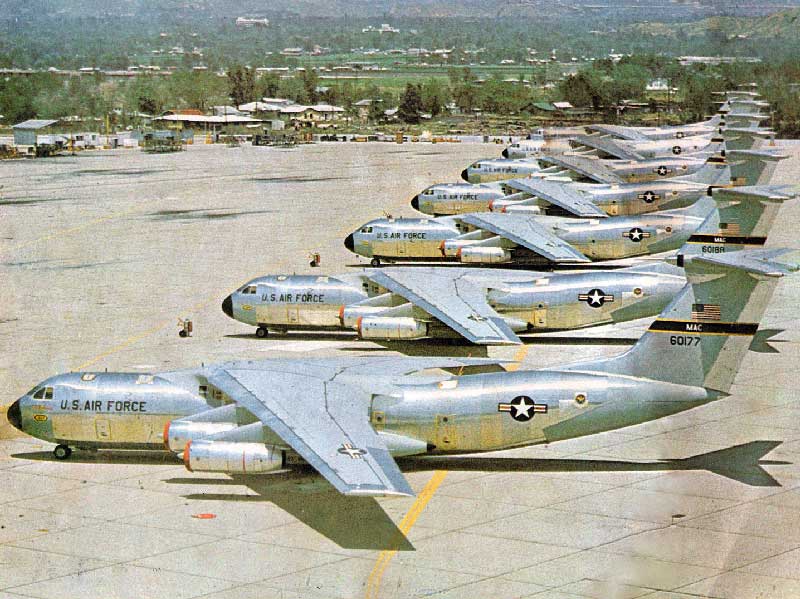
A very early shot of 177 and her sisters, submitted by Gary Wilson.
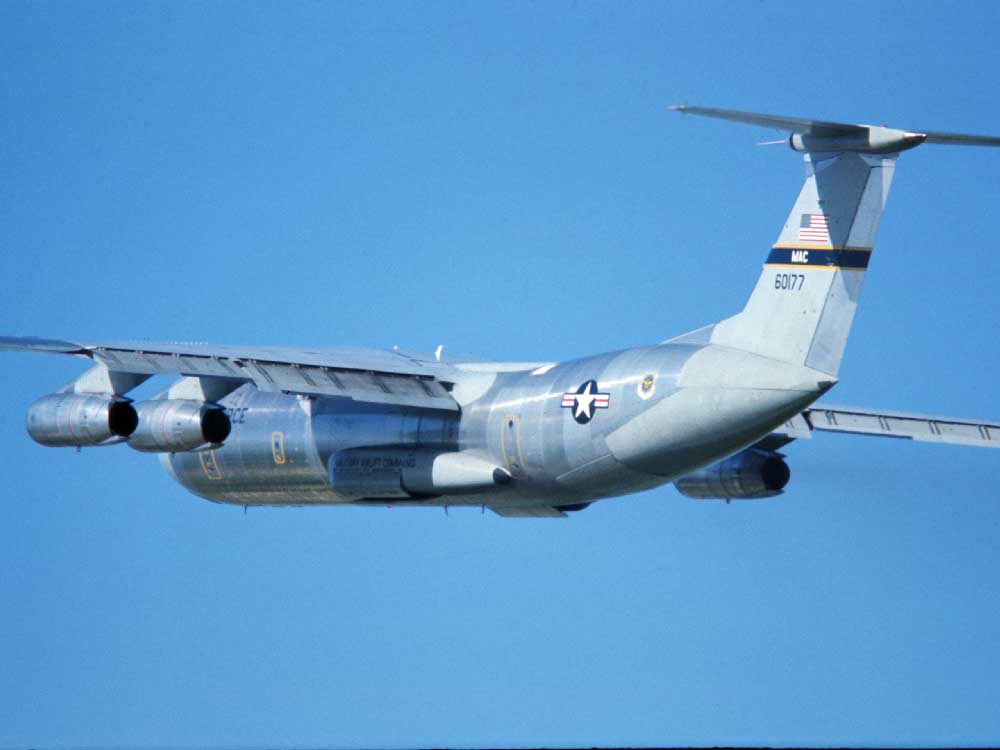
Date:January 1968
Location:Hickam AFB
Copyright © - Nicholas Williams
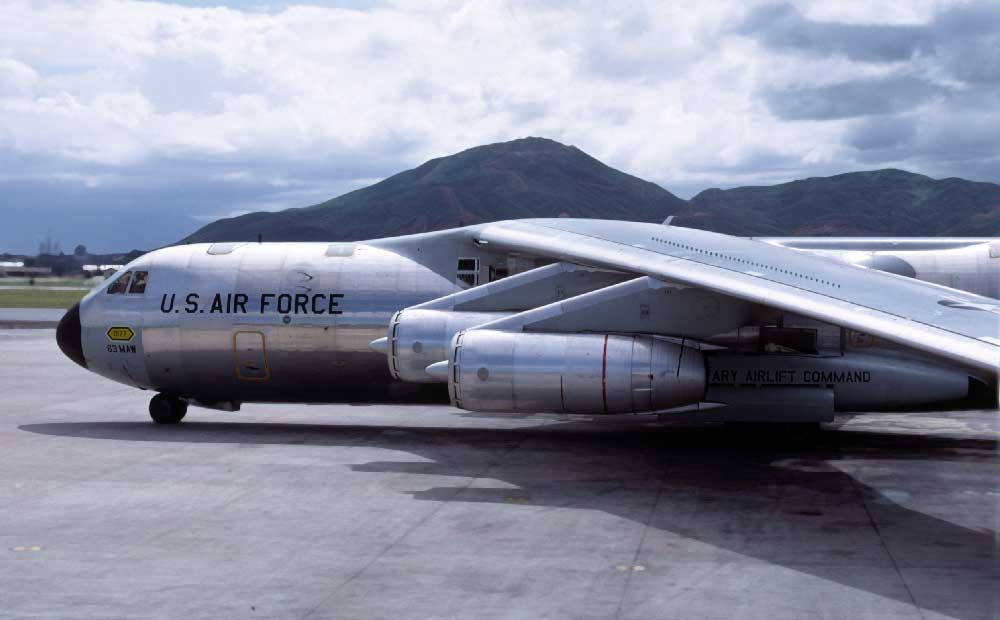
Date:August 1968
Location:Danang, RVN
Copyright © - Nicholas Williams
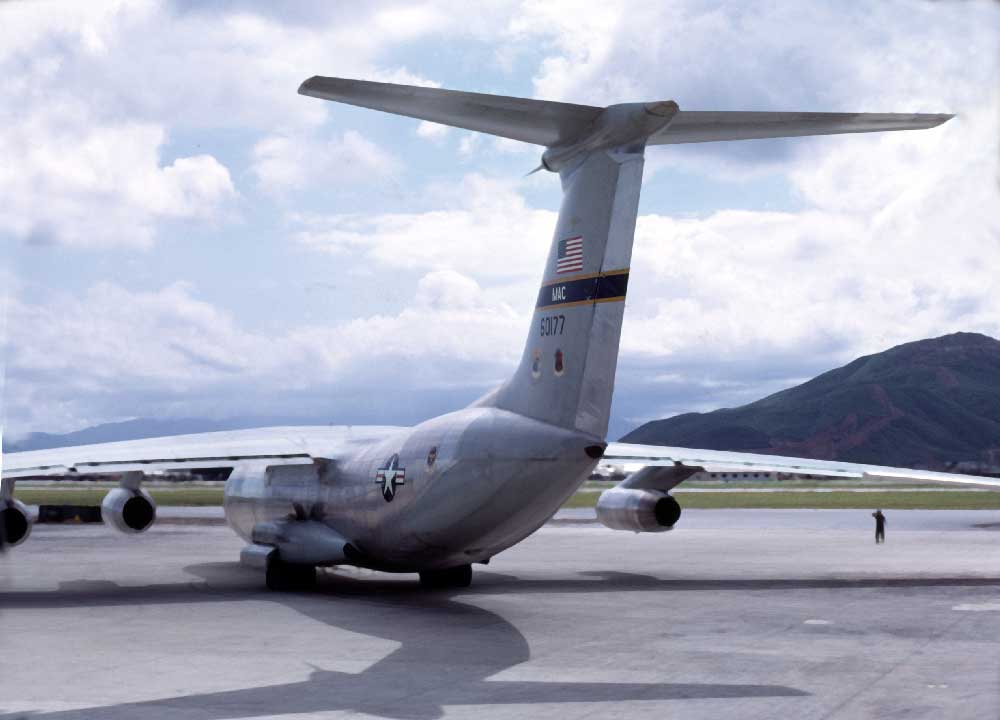
Date:August 1968
Location:Danang, RVN
Copyright © - Nicholas Williams
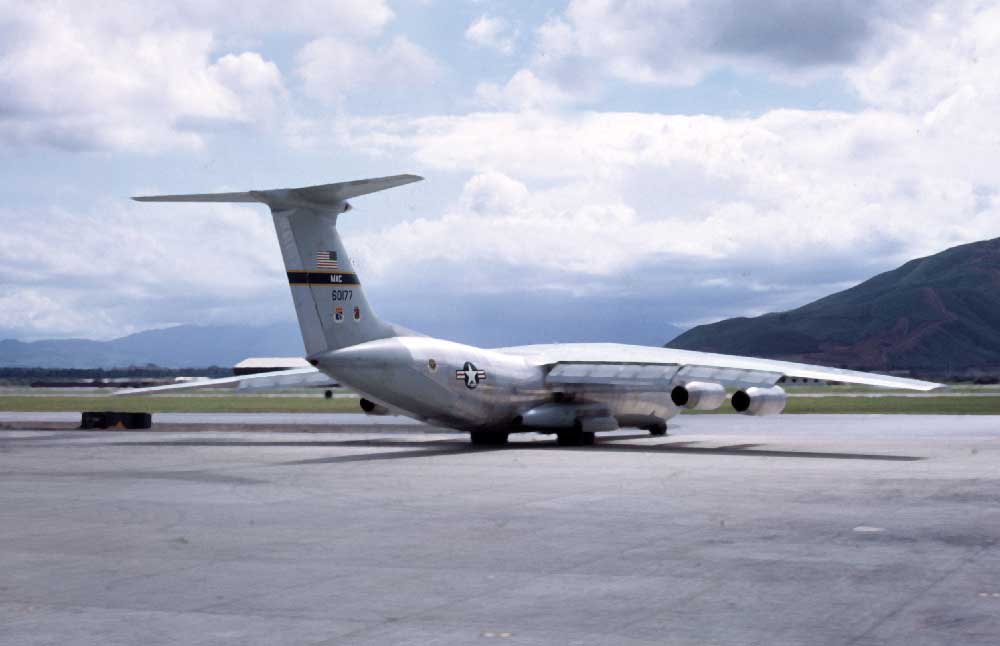
Date:August 1968
Location:Danang, RVN
Copyright © - Nicholas Williams
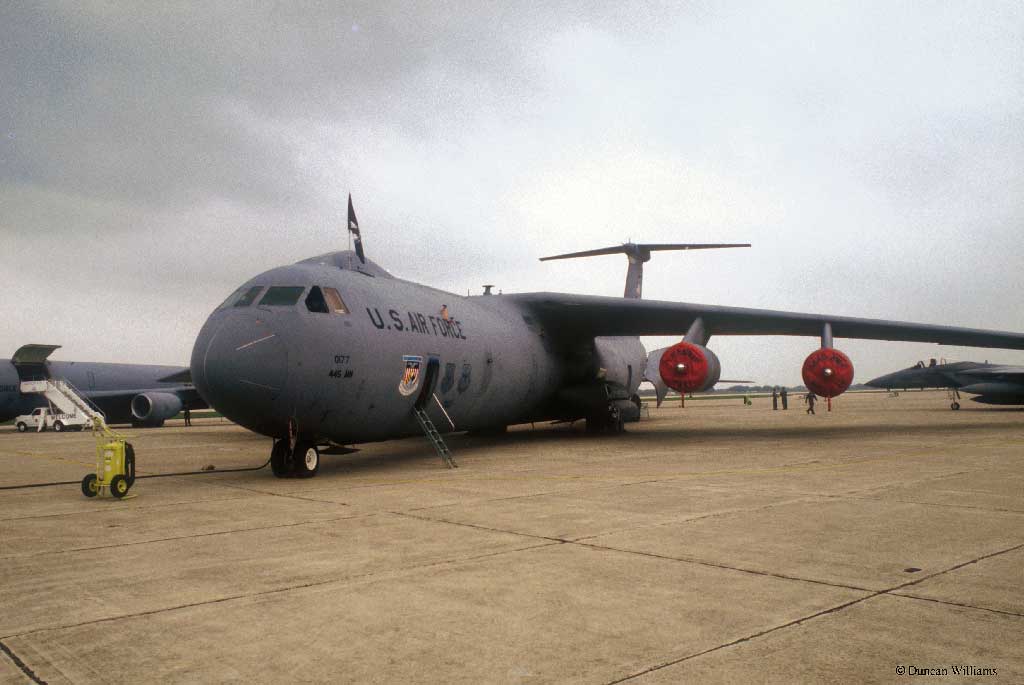
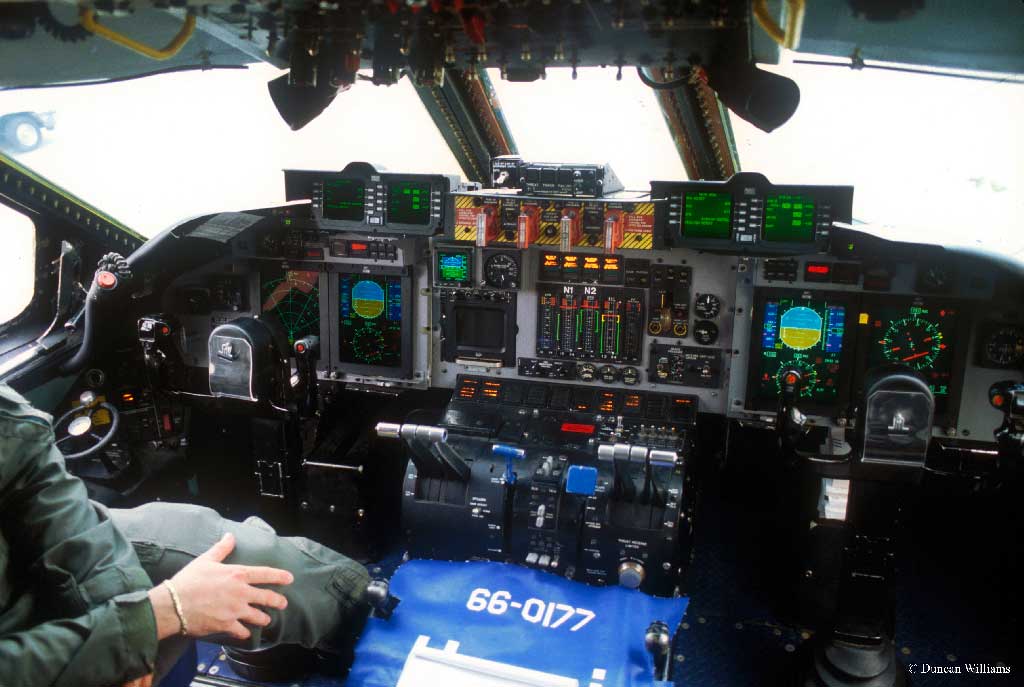
Both the exterior and cockpit shot were taken at Randolph AFB when 66-0177 was
there for the 25th anniversary of the first mission to Hanoi.
Copyright © - Duncan Williams.
A SORT OF HOMECOMING
Airman Magazine
by Tech. Sgt. George Hayward
photos by Staff Sgt. Steve Thurow
The C-141 was on static display at Randolph Air Force Base, Texas, for a
one-day stop during an eight-day airlift mission that would take it across the
Pacific Ocean. Tech. Sgt. Henry Harlow and other crew members chatted with
visitors in the aircraft's open cargo bay, explaining its prominence in the
Vietnam War. A thin, 50-ish man stepped forward with a question.
His name was John Blevins. A retired lieutenant colonel, he'd spent more than
six years as a prisoner of war in Vietnam until his release on March 4, 1973.
He wanted information about an aircraft that flew him out of Hanoi. That
aircraft - also a C-141 - had been his liberation, a resurrection of sorts.
He'd heard Harlow could help him.
Harlow excused himself, and returned a minute later carrying an open binder. He
turned it so Blevins could read the page. It was a passenger manifest for a
flight from Gia Lam Airport in Hanoi to Clark Air Base, Philippines - March 4,
1973. The aircraft was a C-141 bearing tail No. 660177.
This aircraft.
The eyes of both men moistened. "Welcome home," Harlow whispered. "This was
your aircraft."
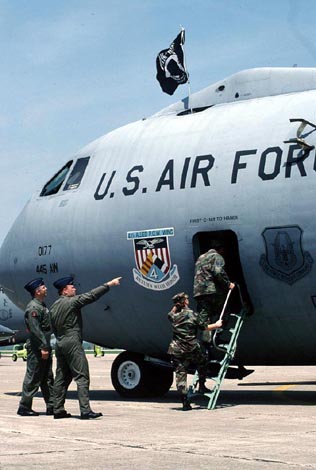
More than 25 years later, one of the aircraft that brought them home has
become a traveling POW museum. To many former POWs, it's a sort of
homecoming.
Twenty-six years before it sat on the Randolph flight line, aircraft No. 660177
was one of 16 Air Force C-141s that carried American POWs home during Operation
Homecoming. According to Harlow, just 11 of those aircraft still fly. Four of
them, including 660177, are assigned to Air Force Reserve Command's 445th
Airlift Wing at Wright-Patterson AFB, Ohio.
But this aircraft, nicknamed "One-Seven-Seven," has even greater significance
to POWs. It flew the first Homecoming mission, carrying 40 men out of Hanoi on
Feb. 12, 1973. Today, it's often called the "Hanoi Taxi" and travels the world
not only as an operational airlifter, but as a monument to brave men and their
families.
"Although this was the first aircraft out of Hanoi, it represents all of the
Homecoming freedom flights," Harlow said. "It also represents the POWs who
didn't get a chance to come home and the families who didn't see their husbands
or fathers come down that ramp."
Harlow, an air reserve technician, is the senior adviser for an ongoing POW
"mission" that started four years ago when the 445th took possession of the
aircraft. Its new crew chief, Tech. Sgt. Dave Dillon, noticed a worn blue label
stuck to the engineers' panel. Just a couple inches long, it bore two words:
HANOI TAXI.
"We started asking questions and collecting information," Harlow said. "It just
kind of steamrolled from there."
It steamrolled through the drive of Dillon, Harlow, Tech. Sgt. Jeff Wittman and
a handful of other reservists in the 445th. They've volunteered time and money
to turn One-Seven-Seven into a POW museum. The aircraft's nose art is the
shield of the 4th Allied POW Wing, the organization of Vietnam POWs. Inside, a
plaque commemorates the first Homecoming flight on Feb. 12, 1973, and the walls
are lined with photos documenting the POWs' captivity, release and homecomings.
Visitors can leave the aircraft with a fistful of literature on POW issues.
"The unit supports us, but many times we use our own money to obtain specific
items for the display," Harlow said. "And it's not work to us. It's a labor of
love."
The aircraft's crew has become passionate in their admiration for the strength
and bravery of the POWs. Their stop at Randolph was part of a small POW reunion
(see "Freedom Flight" in September's Airman), and Senior Master Sgt. Gary
Fernandez, a flight engineer, collected autographs of former POWs for his young
children. "Why do people want autographs of celebrities?" he asked. "These men
are the real heroes. They have something to teach us, something we can look up
to."
Today, the aircraft is on the A-list of air show invitations, but frequently
has to turn away the invites because it still flies real-world missions,
including airlift operations earlier this year to Kosovo. "The only reason we
can put the aircraft on display is if it's not committed to a mission," Harlow
said.
Now 43, Harlow was a young, active duty airman during Operation Homecoming and
remembers following it in the news. He's become the aircraft's senior advisor
because he's a walking warehouse of POW knowledge. "It's a subject I've always
been interested in," he said. "I get the information wherever I can. I research
and read everything I can get my hands on."
He shares that lore with anyone who wants it. He gets several queries via mail
each month, and left a 1998 airshow in Oshkosh, Wis., with 114 requests for
information. "It took about three months, but every one of them has been
answered," he said.
Harlow's knowledge includes detailed facets of those earlier, historic missions
flown by One-Seven-Seven and other C-141s, back when the aircraft were painted
white, with the bright red cross signifying a medical plane.
"The flight nurses basically bought the base exchange at Clark Air Base out of
perfume, and sprayed down the entire interior of each airplane - all the
bulkheads, from head to tail," he said. "The POWs have told us that as they
came around to the ramp at the back of the airplane, they could smell it. And
to them, it smelled like America."
Many POWs were captured before the C-141 entered service, so they'd never seen
the new airlifter until they boarded one for a flight to freedom. "They tell us
the aircraft represented America," Harlow said. "It was the cleanest, most
beautiful thing they had seen in a lot of years."
Lt. Col. Norlan Daughtrey can't say if his plane was clean. As one of the
longest-held POWs, he was on that first flight out of Hanoi, Feb. 12, 1973,
aboard One-Seven-Seven. "I never saw that aircraft because when I got on it, I
was crying so hard," he said. "And they were tears of joy."
Lt. Col. John Yuill was one of the last POWs out of Hanoi in 1973. A B-52
pilot, he was shot down and captured during Operation Linebacker II, the
December 1972 bombing campaign that is credited with winning the POWs' release.
More than 26 years later, he stood on the ramp of the Hanoi Taxi at Randolph,
looking back into the cargo bay lined with photos of his fellow POWs. It was
like looking through a time tunnel.
"You know, I've had only two rides in a C-141 in my life," he recalled. "One
was from Hanoi to Clark Air Base. The other was from Clark to Sheppard Air
Force Base, Texas. So anytime I see a C-141, that's what I think of."
Harlow said his unit tries to make the aircraft available for any POW who
wishes to visit. Such visits can be very emotional, or very solemn. He recalled
one former POW who stared at a single photograph for nearly 40 minutes. "It's a
closure of sorts," Harlow said. "When he was ready to move on, he moved on."
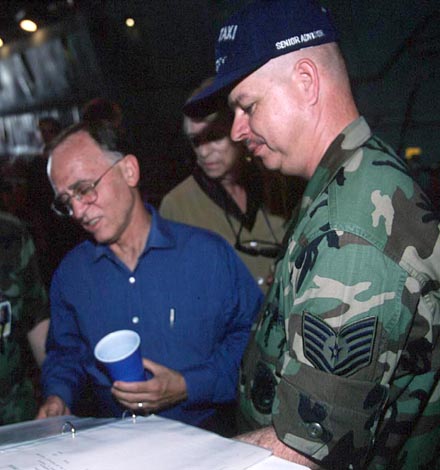
Tech. Sgt. Henry Harlow shows retired Lt. Col. John Blevins the manifest
for Blevins' 1973 freedom flight aboard the Hanoi Taxi. When he returned to the
aircraft 26 years later, he had come full circle.
To Lt. Col. John Blevins, that Friday afternoon at Randolph was more than a
closure. He stood in the bay of the plane that carried him to freedom,
struggling to find words. "It hits you in the gut," he said haltingly. "It's
unbelievable."
He called it a sort of homecoming.
If you want information about the Hanoi Taxi or any Vietnam POW, Tech. Sgt.
Henry Harlow will help you find the answer. Write him at:
PO Box 728
Fairborn, Ohio 45324-0728
Milwaukee Journal Sentinel
August 1, 2004
Air Force's 'Hanoi Taxi' Offers Sense Of History On The Fly
Plane transported U.S. POWs out of Vietnam
By Meg Jones
Oshkosh - Among the many planes attracting crowds at EAA AirVenture this
weekend is an Air Force Lockheed C-141C that has seen its share of sorrow and
heartache.
On Feb. 12, 1973, the military transport airlifted the first American prisoners
of war from Gia Lam Airport in Hanoi and took them home to their families.
It was nicknamed the "Hanoi Taxi" by the just freed prisoners who signed their
names on a bulkhead inside the plane during the flight home.
Painted in the original colors and markings used in 1973, it's still being used
but now in a war far from the jungles of Vietnam. The C-141C is part of the
rotation of planes used by the 445th Airlift Wing based at Wright-Patterson Air
Force Base in Ohio that take supplies and medical personnel to Iraq,
Afghanistan, Kuwait and Germany and airlift injured soldiers out of those
countries.
The plane is also a flying museum - there are photos of the American POWs
leaving Hanoi dressed in dark trousers and gray jackets, grinning while sitting
inside the plane and returning to America to greet their families. There are
North Vietnamese propaganda pictures of POWs and drawings of the torture
endured by the men.
The bulkhead with the signatures of the POWs is under protective plastic, and a
plaque lists each state with the number of Americans still missing from
Vietnam. Wisconsin has 33.
For Tim Baldwin, piloting the "Hanoi Taxi" gives him a sense of history.
"We get a lot of POWs who come to the air shows" who want to go on board again,
Baldwin said shortly after the C-141C arrived at AirVenture.
The 168-foot-long plane can hold as much as 34 tons of cargo or 200 soldiers,
103 litters and 14 seats. It travels at a top speed of 500 mph and can soar as
high as 41,000 feet. It travels to the Middle East and Europe four to five
times a week and generally spends only three to four hours on the ground in
Iraq or Afghanistan for safety reasons, Baldwin said.
Last week Baldwin and the other crew members carried out 15 patients on litters
and 23 walking wounded from Iraq.
Many wounded soldiers don't notice the photos of the Vietnam POWs on the walls
until well into the flight, Baldwin said.
"I think they're just very happy to be going home. Once they're on board they
see the pictures, and they can see the history," Baldwin said.
Waiting in the line that stretched out the back of the plane was Jerry Duncan,
who was visiting AirVenture from Dayton, Ohio, with his wife, Debbie, and
11-year-old son Chris. Duncan was surprised to see the plane considering he had
flown it - he recognized the tail number - from 1977 to 1982 when he was based
in New Jersey.
"I haven't seen one of these planes in 22 years," said Duncan, who remembered
watching the return of the POWs from Vietnam while he was a sophomore at the
Air Force Academy.
His roommate's father, Donald Waltman, was one of the returning prisoners of
war. Duncan found Waltman's signature in black marker on the bulkhead.
"We sat and watched them on a black and white TV unload the plane. We got some
time off to watch it. It was cool," Duncan said.
The Air Force will soon mothball the C-141. Once among the workhorses of
military transport planes, the last handful still flying will retire by 2006.
The "Hanoi Taxi" - which will be on display at AirVenture through Monday - is
destined for the Air Force museum at Wright-Patterson next year.
From a 'history' document generated at WRALC
The Hanoi Taxi
The last topic deals with one of the Air Force's most hallowed aircraft C-141B
T/N 66-0177, better known as the Hanoi Taxi. On 12 February 1973, this
Starlifter became the first U.S. aircraft to transport American Prisoners of
War (POWs) to freedom from Gia Lam Airport, Hanoi, Socialist Republic of Viet
Nam (North), during Operation Homecoming. The Hanoi Taxi derived its name from
the inscriptions written by the POWs on the flight engineers panel. Over the
years the signatures and declarations of the proud men flying home to freedom
have been lovingly preserved by the crews who have flown the great old lady.
Over the years T/N 66-0177 has become for all intents and purposes a flying
museum.
Late in FY01, leaders of the 445th Airlift Wing (445AW), Wright-Patterson AFB,
Ohio, the using unit, knowing that number 66-0177 would be retired in late
2004, asked their superiors at HQ AFRC for permission to repaint their plane
the 1970s gray and white paint scheme during its final programmed depot
maintenance (PDM) at WR-ALC in FY02. Not only did AFRC officials grant
permission but the also agreed to fund the repaint. Center C-141 SPO workers
took great care with the Hanoi Taxi during its fourth quarter FY02 PDM. Even as
they completed their work for the formal final roll out ceremonies, a special
pilot arrived with 66-0177's regular crew to fly her home for the last time.
Major General Edward J. Mechenbier was the special pilot. Then serving as
Mobilization Assistant to the AFMC Commander, Lester Lyles, Mechenbier was one
of those young POWs who came home on the Hanoi Taxi@ from the terrible prison
he and his fellow POWs named the Hanoi Hilton. In June 1967, then Lieutenant
Mechenbier, stationed at Da Nang Air Base (AB), Republic of Viet Nam (South),
left on his 80th mission over the North as part of Operation Rolling Thunder.
When the enemy shot down his F-4C Phantom fighter aircraft he bailed out and
was captured. He spent the next five and eight months in brutal captivity. The
day of his liberation, Mechenbier recalled that the C-141, was the most
beautiful thing I had seen in six years!@ Nearly 30 years later the command
pilot with 3,500 flying hours, had come full circle. On 7 October 2002,
hundreds of people gathered in front of the Robins AFB Base Operations building
to bid farewell to the Hanoi Taxi, the Air Force's flying tribute to the
Vietnam War=s POWs and MIAs.
Among those present were the C-141 SPO employees who performed the PDM, several
former POWs, and representatives of Middle Georgia POW/MIA groups as well as
the Center Commander, Major General Donald Wetekam, Center Vice Commander
Brigadier General Larry Stevenson, and Center Civilian Director Steve Davis.
Those of us who toured the interior of the aircraft were moved by the plaques,
documents, and photographs of the 1973 homecoming which had taken their places
beside the original POW=s names and signatures to form this flying exhibit. In
addition, etchings of the names of Vietnam era MIAs were also taken from the
Vietnam Wall in Washington, D.C. and mounted in the plane=s interior.
In his farewell address Mechenbier told the audience great to be doing
something positive, but more importantly this airplane is a symbol of freedom
of the spirit. Flying it is a tribute not only to me and the POWs, but to
everybody that's brought this together. At 1018 hours, General Mechenbier
lifted the Hanoi Taxi gently off the Robins AFB tarmac circled the field,
tipped his wing in salute and headed home to Ohio. Truly as he had said
earlier, "Flying it out today in this white and gray paint scheme will be a
nostalgic trip back for me." Indeed, it was a moving experience for all those
present.
This was grabbed from an Air Force Reserve Web site....
October 7, 2002
'Hanoi Taxi' returns to duty with new look
ROBINS AIR FORCE BASE, Georgia - The "Hanoi Taxi," the Air Force's flying
tribute to the Vietnam War's prisoners of war and missing in action, received a
makeover and a hero's sendoff here before returning home Oct. 7.
The C-141 Starlifter was the first aircraft to airlift American POWs to freedom
from Gia Lam Airport in Hanoi, North Vietnam, Feb. 12, 1973.
The 445th Airlift Wing, Wright-Patterson AFB, Ohio, which owns Aircraft No.
66-0177, asked Headquarters Air Force Reserve Command for permission to repaint
the aircraft in the 1970's white and gray paint scheme. AFRC officials approved
and funded the work, which was done while the aircraft underwent programmed
depot maintenance at the Warner Robins Air Logistics Center here.
Air Force Reserve Maj. Gen. Edward J. Mechenbier, one of the POWs repatriated
aboard the Hanoi Taxi, flew the historic aircraft from Robins back to
Wright-Patterson.
"It was the most beautiful thing I had seen in six years," said Mechenbier,
mobilization assistant to the commander of Air Force Materiel Command,
referring to the first time he saw the Hanoi Taxi.
Mechenbier, a command pilot with more than 3,500 flying hours, was assigned to
Da Nang Air Base, South Vietnam, and was on his 80th mission over North Vietnam
when his F-4C fighter was shot down in June 1967. He spent nearly six years as
a POW before taking his first ride in the Hanoi Taxi.
Middle Georgia POW/MIA groups, C-141 maintenance workers who worked on the
aircraft, 445th AW crewmembers, and Headquarters AFRC and Robins officials
participated in the sendoff ceremony Oct. 7.
The Hanoi Taxi's name comes from the writing on the flight engineer's panel by
the POWs aboard the plane for the freedom flight. Signatures of the freed
prisoners have been preserved on the panel over the years and are the
centerpiece of what is essentially a "flying museum." Plaques, documents and
photographs of the homecoming are part of the on-board exhibit researched and
created by the 445th AW. Etchings of the names of those who are missing in
action were taken from the Vietnam Wall in Washington, D.C., and are mounted on
the plane.
"The Hanoi Taxi is a tribute to the men and women who serve in the Air Force,"
Mechenbier said. The general added that it is important for the American public
to know about the airplane and what it means to the nation.
The aircraft, which has been upgraded to a C-141C with improved avionics, is
used to transport troops and .cargo worldwide. It is one of four C-141s flown
by the 445th AW that were involved in Operation Homecoming, the repatriation of
American POWs in the Vietnam War.
All C-141s are scheduled to be retired from the Air Force inventory by 2006.
Here's a note I received from someone at Wright Patterson:
From: Jonathan Bell
To: C141HEAVEN
Date: Oct 15, 2004 - 7:03am
The Hanoi Taxi (66-0177) is stationed at Wright-Patterson AFB (now a "C" model)
and will eventually go to the Air Force Musuem. It has been repainted to the
white over grey paint scheme (like it was in 1973), pictures line the cargo
walls of the POW flight, a plaque is at the front of the cargo compartment with
the names of the first group of POW's released, and there is a panel with
signatures of POW's that have revisited her. Just thought you'd like to know.
Jonathan Bell
CAPT, 356 AS, PILOT
PS. The 356 AS will be the last C-141 squadron.
A note received from Ed Horton:
I got to your web page through the guest book at www.610mass.org.
I was stationed at Yokota AFB from 69-73, flight line APG.
I can't remember what month it was but a message came out to remove the red
crosses from the tails of the 141s. I was at your web site in the
C-141:Chronology section and found the 12 FEB 73 article:
"Tail number 660177, painted white with a large Red Cross on its tail landed at
Gia Lam airport, Hanoi, Vietnam Feb. 12, 1973. The plane arrived in Hanoi as
part of "Operation Homecoming" - the return of America's Vietnam Conflict
POWs."
Now that brought back memories, I helped remove the tail crosses from that
C-141 at Yokota. I remember thinking this was the first C-141 to land at Hanoi
and I'm peeling this red cross off the tail and removing a bit of history. I
decided to save a piece of it as a memento. I took out my wallet and stuck part
of the red cross inside a empty photo holder, and have kept it all these years.
I later ended up working with the retired E-9 Flight Line Chief Mr. George
Siebert who was stationed at Clark and was the senior NCO on that flight on A/C
660177 into Hanoi ... it's a small world.
A note received from Bill Enfield in January of 2005:
Just wanted to let you know from 1972 to 1974 at Norton AFB, Ca. I was the crew
chief of 60-177 THE HANOI TAXI. What a wonderful opportunity it was to take
part in that air lift I will never forget it. I am so glad to know she is still
flying and not at DM a pile of scrap!!
MSGT Bill Enfield USAF RET. Navarre FL.
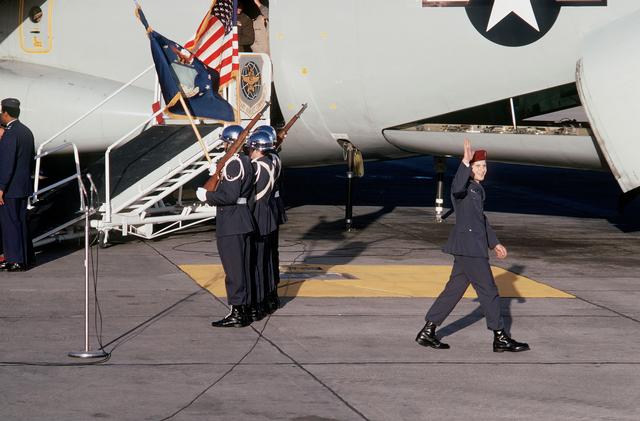
Source: USAF Photo

Source: USAF Photo
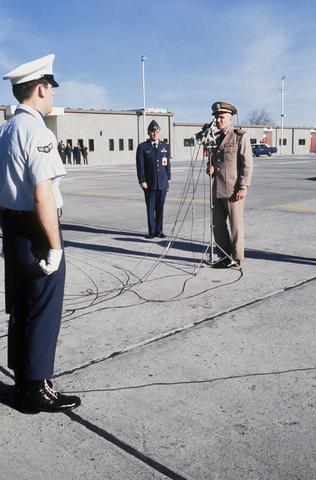
Source: USAF Photo
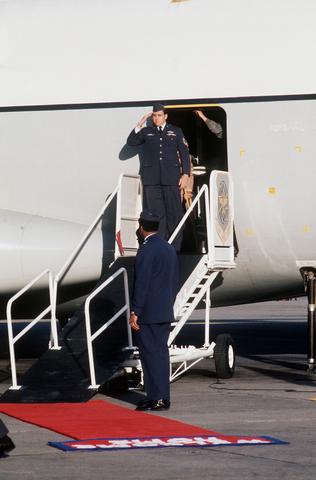
Source: USAF Photo
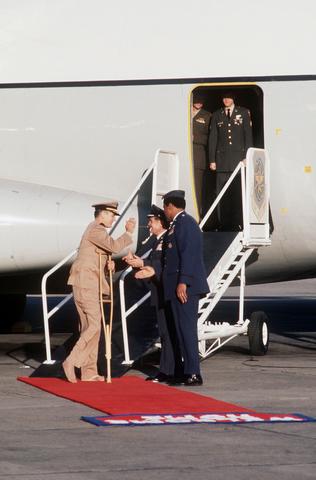
Source: USAF Photo
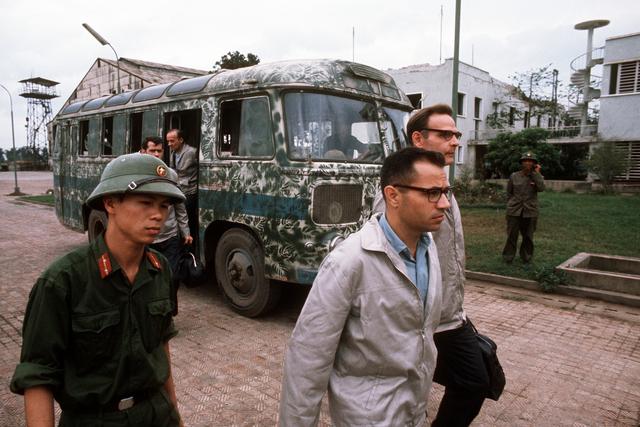
Source: USAF Photo
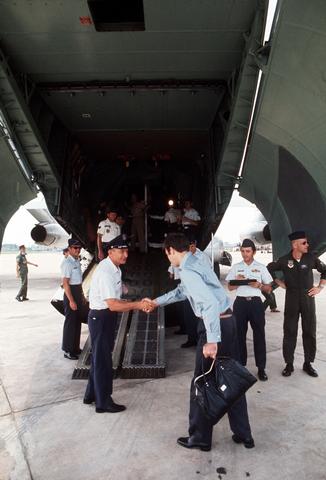
Source: USAF Photo
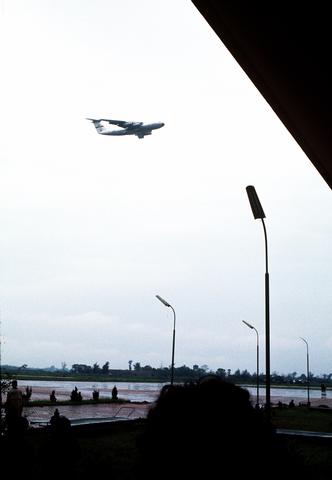
Source: USAF Photo
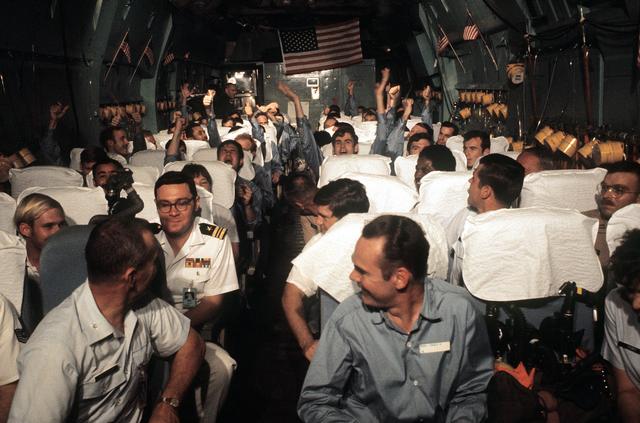
Source: USAF Photo
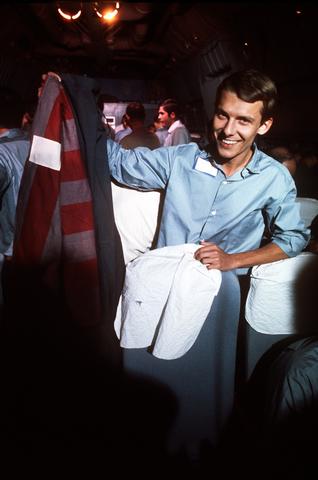
Source: USAF Photo
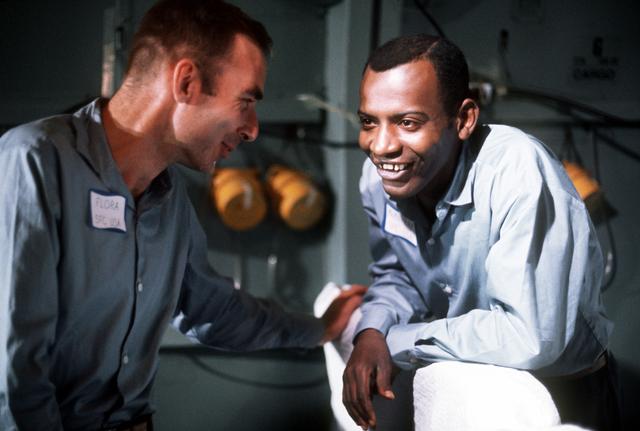
Source: USAF Photo
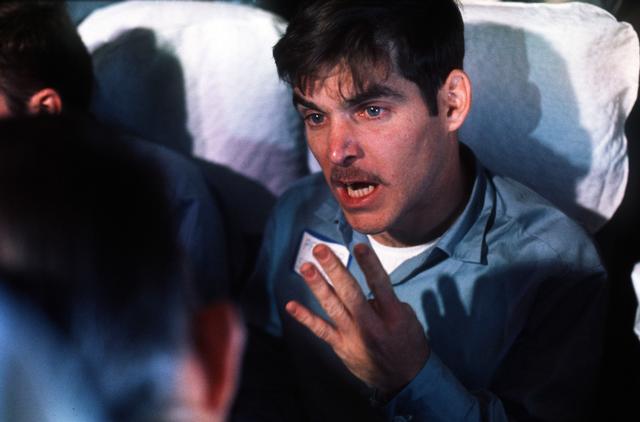
Source: USAF Photo
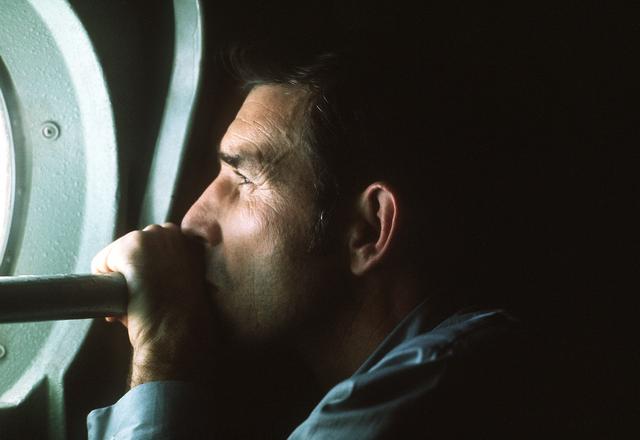
Source: USAF Photo
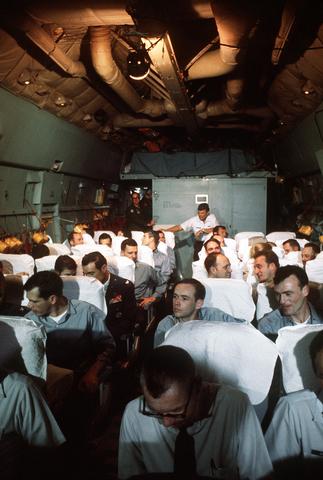
Source: USAF Photo
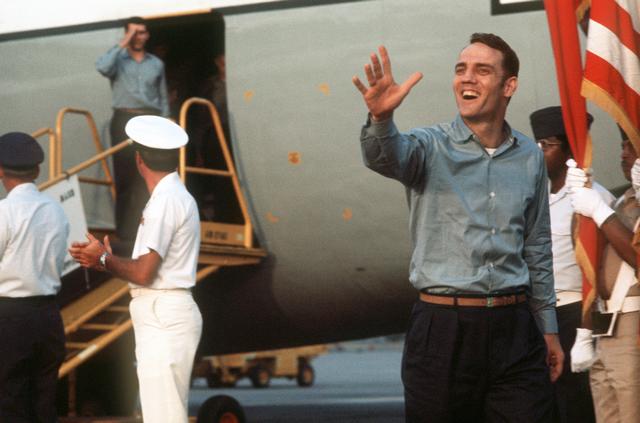
Source: USAF Photo
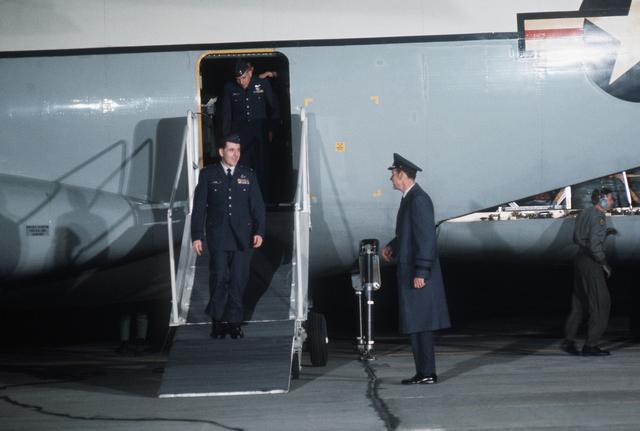
Source: USAF Photo
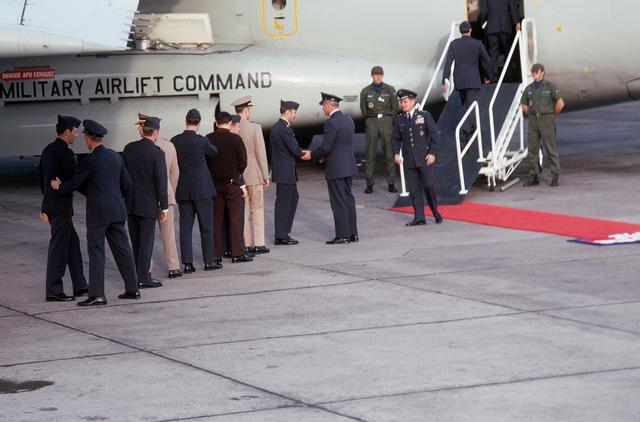
Source: USAF Photo
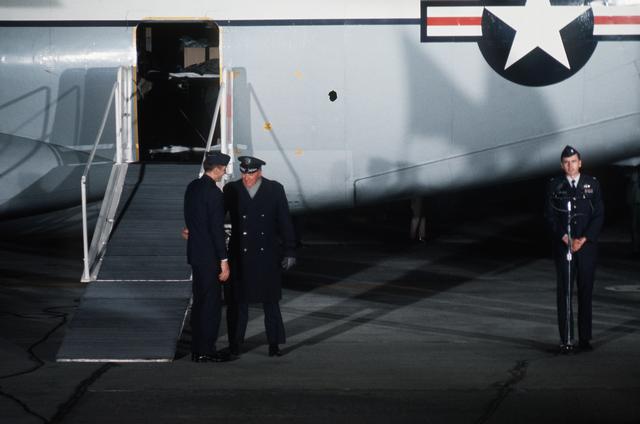
Source: USAF Photo
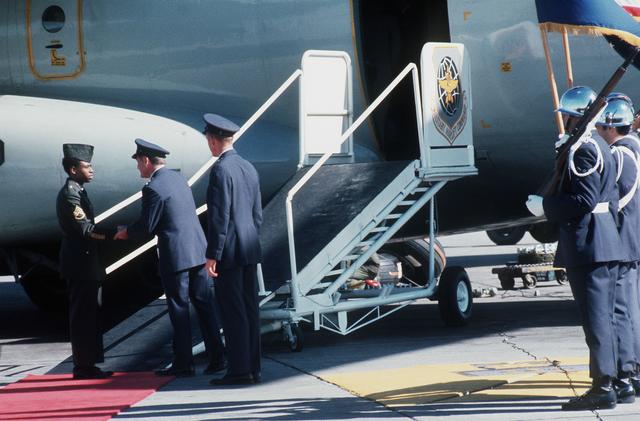
Source: USAF Photo
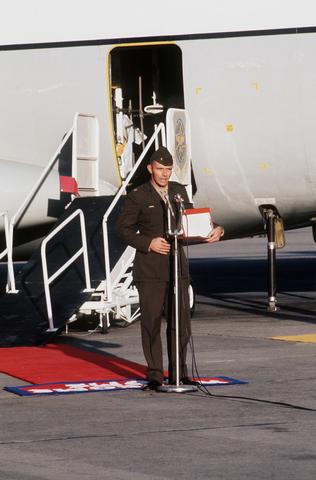
Source: USAF Photo
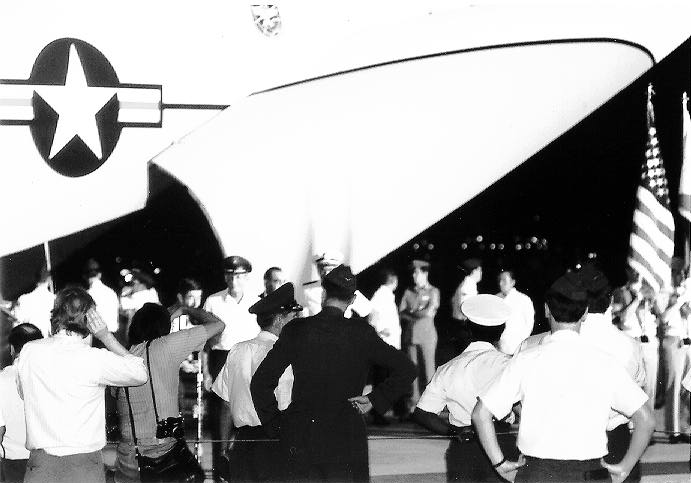
Source: USAF Photo
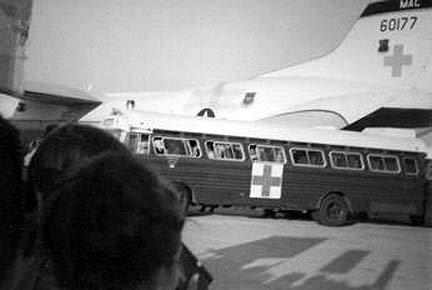
Source: USAF Photo
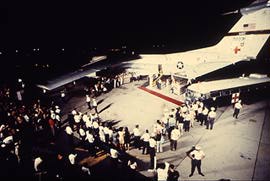
Source: USAF Photo
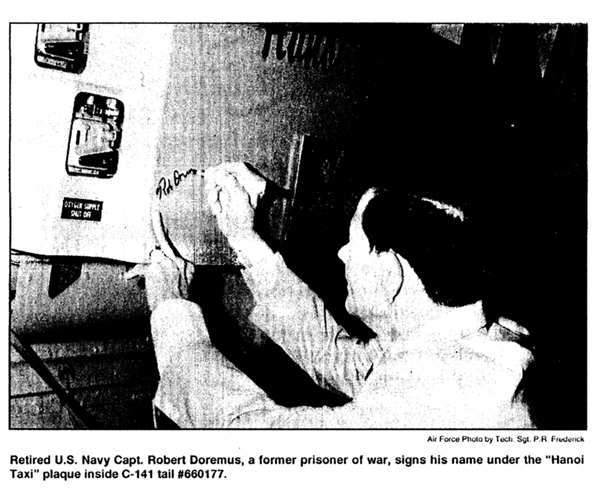
Source: USAF Photo
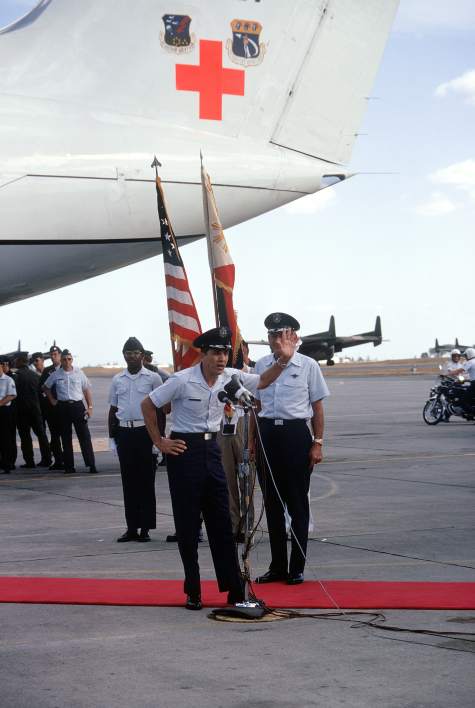
Former POW and U.S. Air Force COL Robinson Risner, at the microphone, waves and thanks the crowd and press prior to boarding the waiting C-141 Starlifter for the flight to the states. Standing behind COL Risner is LT GEN William G. Moore, Commander 13th Air Force. COL Risner was captured on 16 Sep 65 and released by the North Vietnamese in Hanoi on 12 Feb 73.
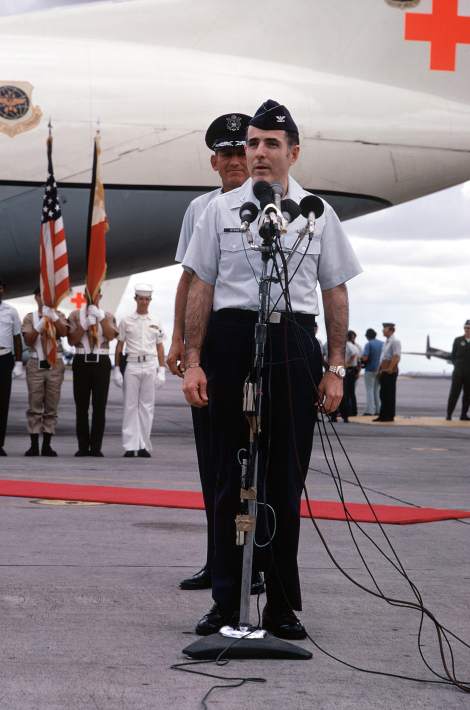
Former POW and U.S. Air Force COL Ronald Edward Byrne Jr. talks to press and well wishes at microphones prior to boarding the C-141 Starlifter for the flight to the states. Behind COL Byrne is LT GEN William G. Moore, Commander 13th Air Force. COL Byrne was captured on 29 Aug 65 and was released in Hanoi by the North Vietnamese on 12 Feb 73.
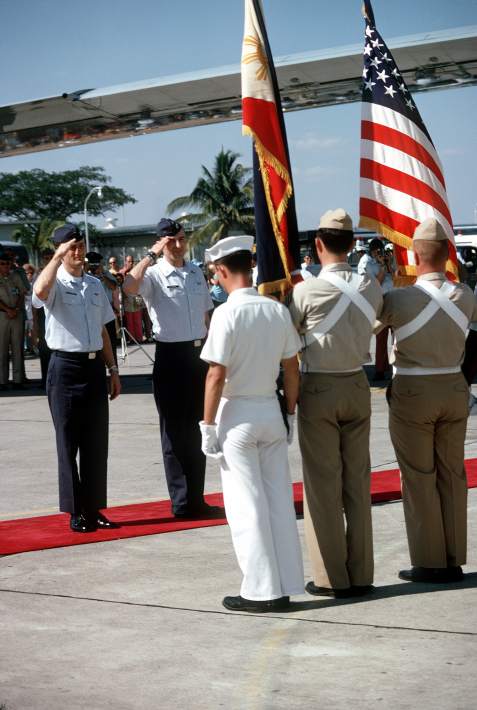
U.S. Air Force ex-POWs, CPT Edward J. Mechenbier, (Captured 14 Jun 67) and CPT Kevin J. McManus (Captured 14 Jun 67) salute the Honor Guard colors on the flight line prior to boarding the C-141 Starlifter for the flight to the United States. Both men were released in Hanoi by North Vietnam on 18 Feb 73.
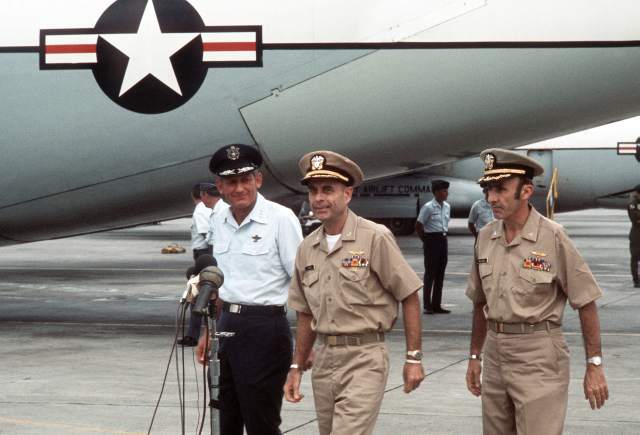
Returned POWs U.S. Navy CPT Jeremiah Andrew Denton (on left), (Captured 18 Jul 65) and Navy CPT James Alfred Mulligan, (Captured 20 Mar 66) along with 13th Air Force Commander, LGEN William G. Moore approach the microphones on the flight line for a farewell statement prior to board the C-141 Starlifter for the trip from Clark AB to sthe states. Both Denton and Mulligan were released by the North Vietnamese in Hanoi on 12 Feb 73 in Hanoi.
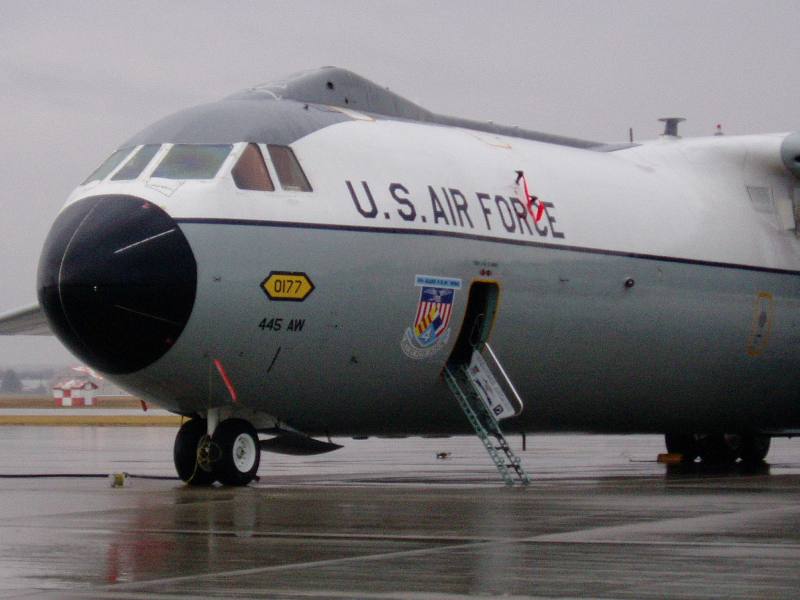
At Wright-Patterson on a rainy day
Copyright © - Frank Saul
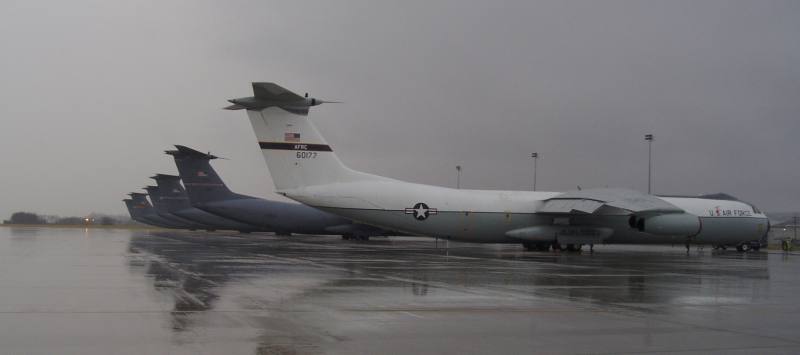
At Wright-Patterson on a rainy day
Copyright © - Frank Saul
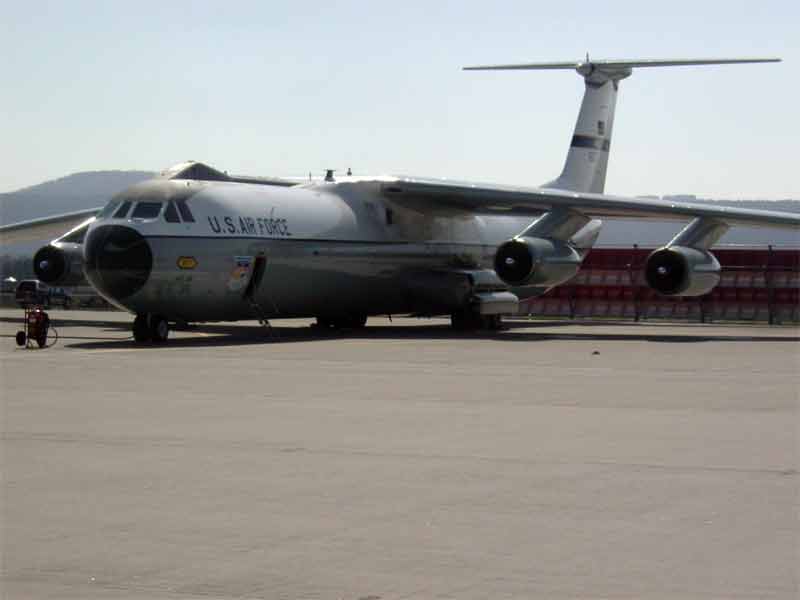
Copyright © - Bob Pirolli
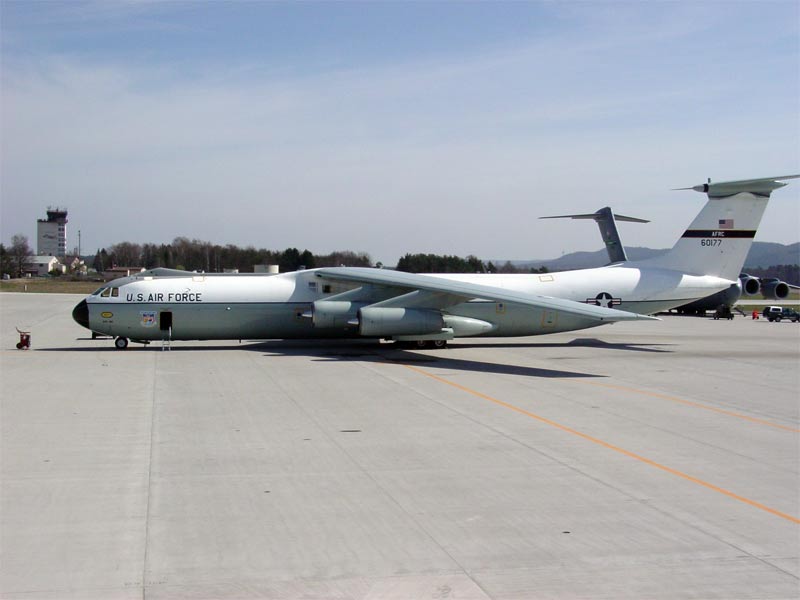
Copyright © - Bob Pirolli
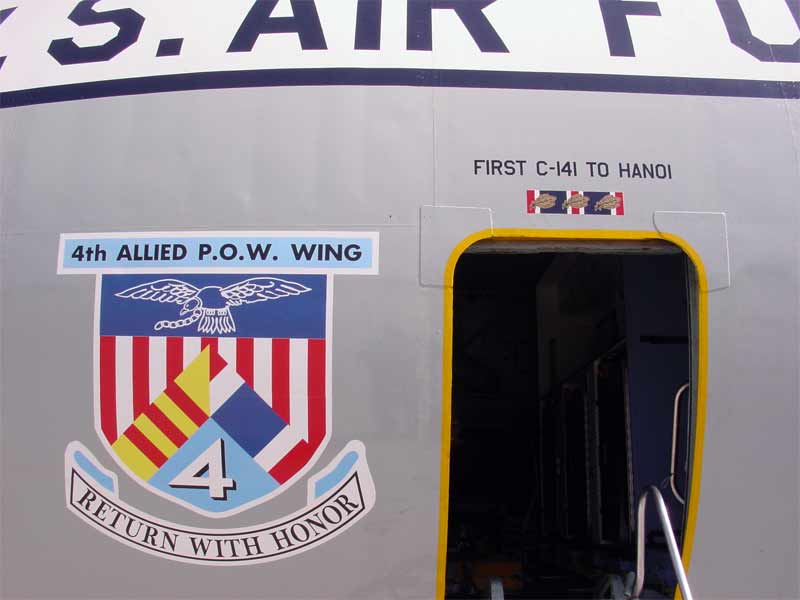
Copyright © - Bob Pirolli
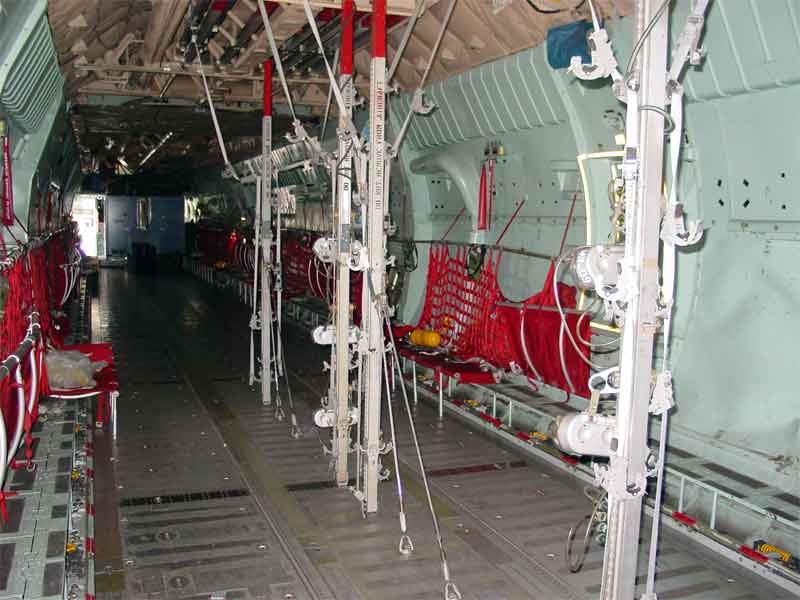
Copyright © - Bob Pirolli
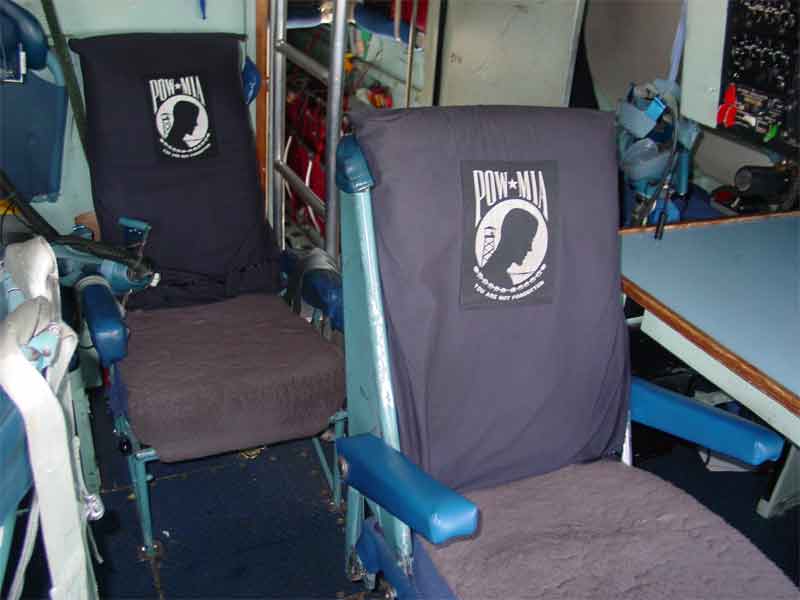
Copyright © - Bob Pirolli
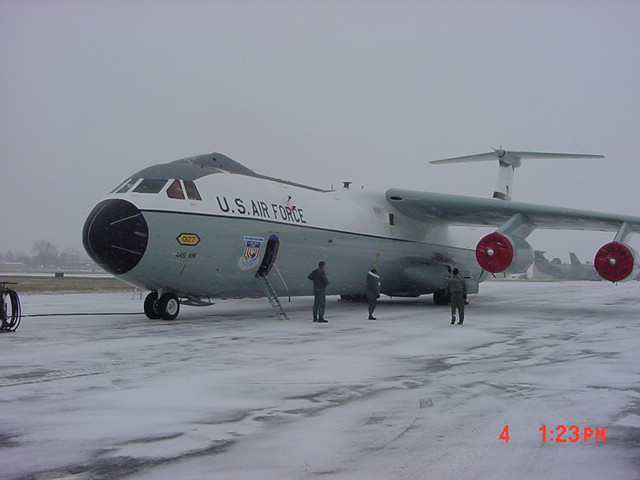
Copyright © - John Mills
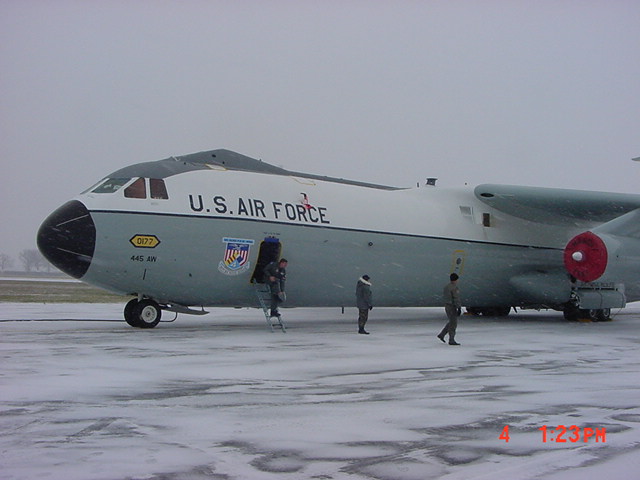
Copyright © - John Mills
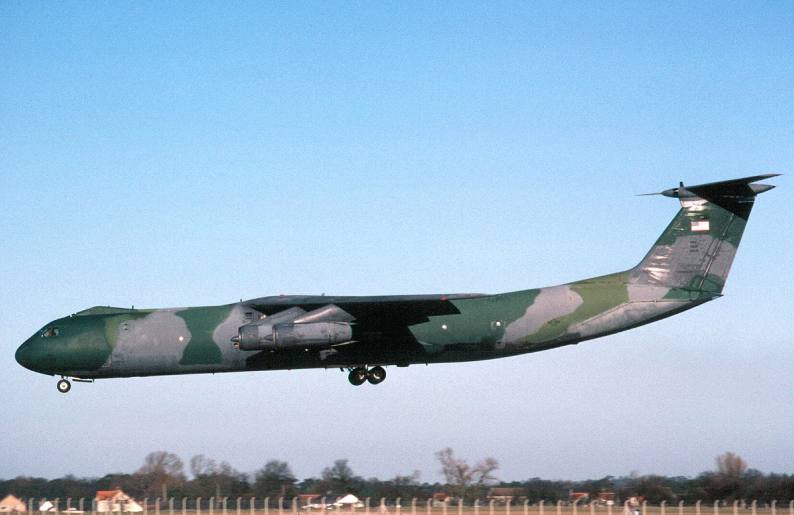
In the ugly green camo days
On December 13th, 2005, 60177 was photographed in anticipation of the upcoming retirement ceremony. Over the course of the next several days I received copied of these official photos and a few others submitted by other folks. Here's a link to those photos: 60177 Photo Shoot
Here's a note from Stefanie Hauck, who flies out of Wright-Patterson:
I'm sending to you photos of the Hanoi Taxi's last overseas flight from Aviano
AB Italy to Ramstein to WPAFB in July 2005. A professional picture was also
taken by Aviano Public Affairs with a group of 445 AW members in front of the
plane before she took off. You can contact Aviano AB to get the picture. I
don't have a copy of it. Here are the pictures I took on the last overseas
flight.
===============================================================================
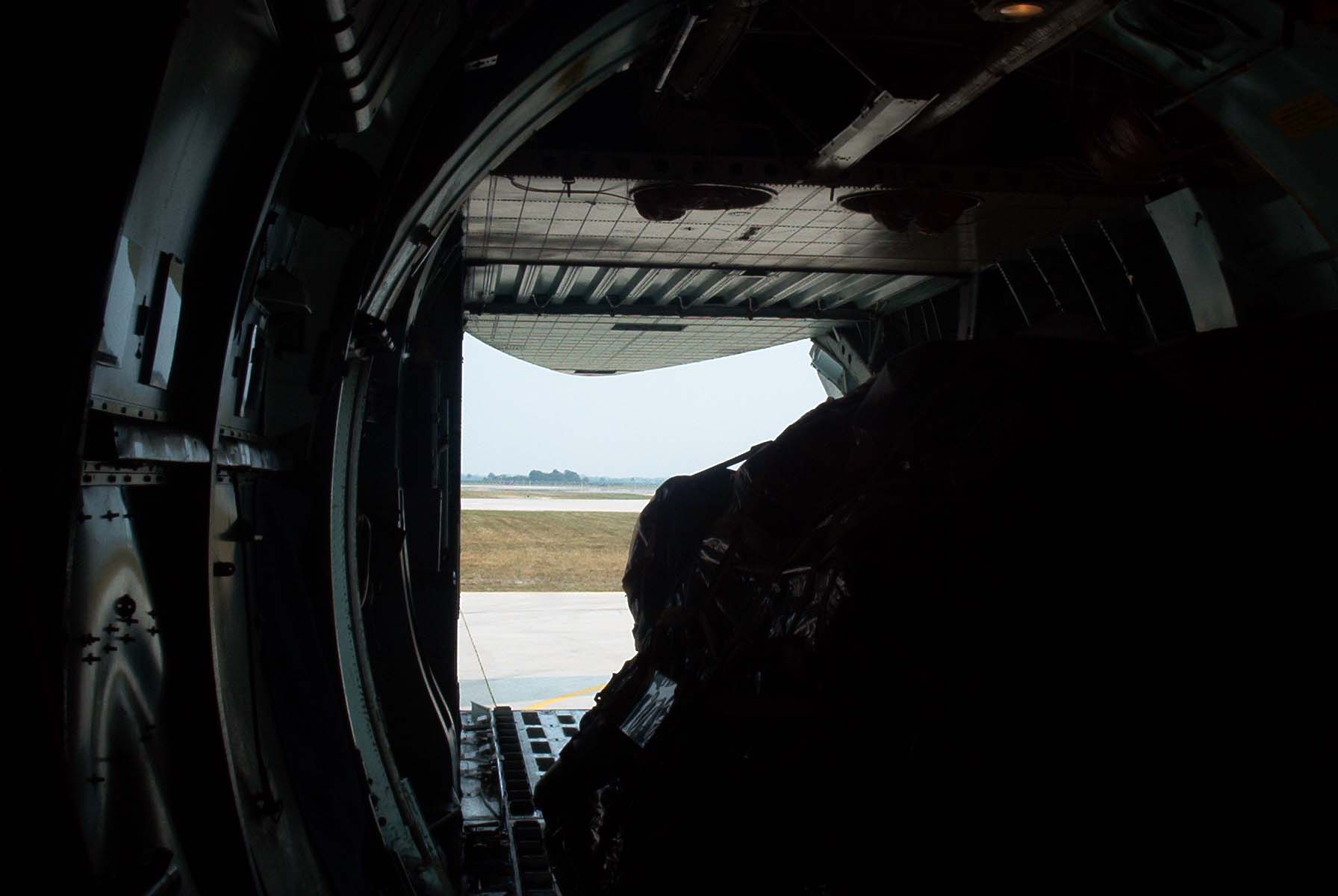
Loaded with goat at Aviano
===============================================================================
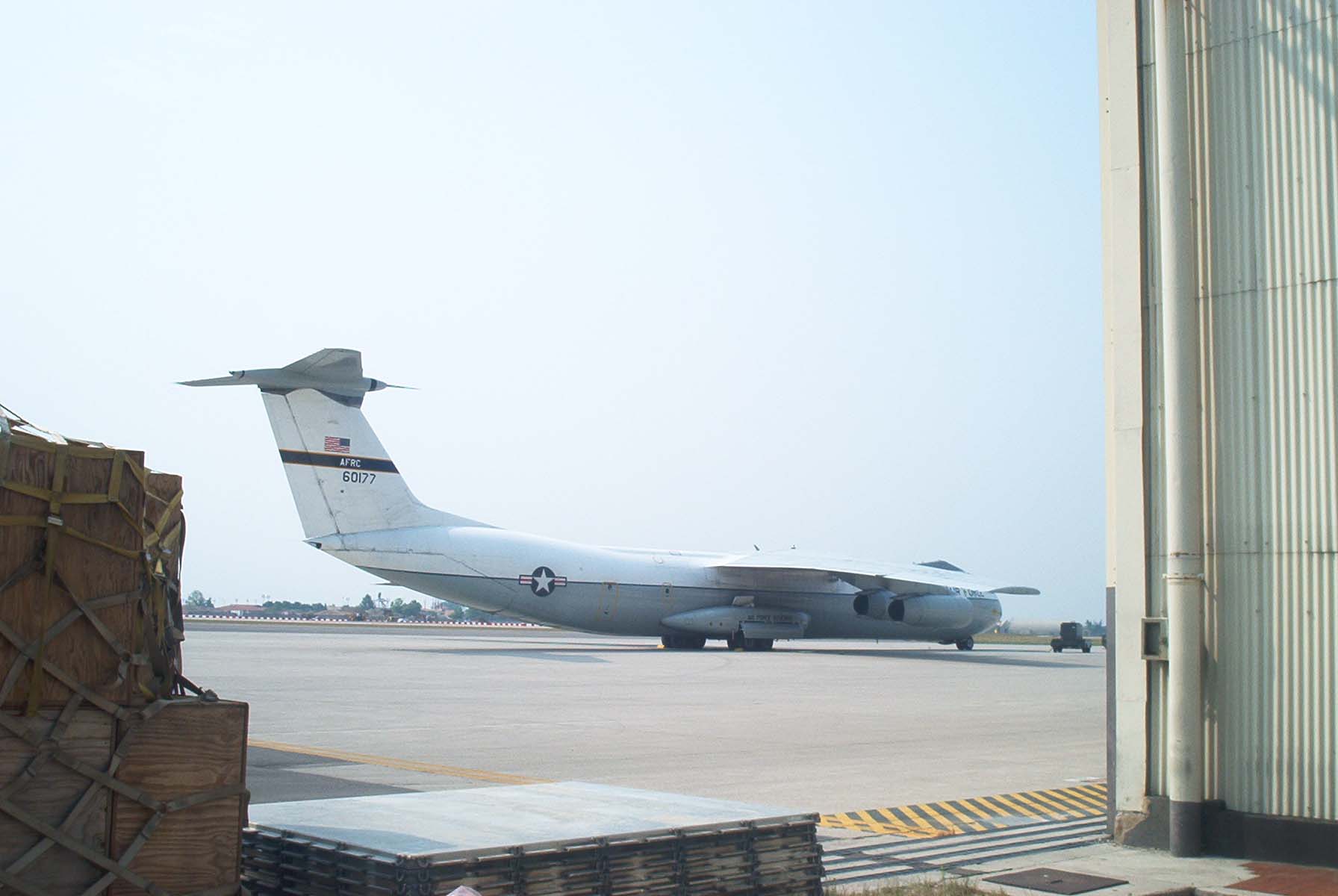
At Aviano
===============================================================================
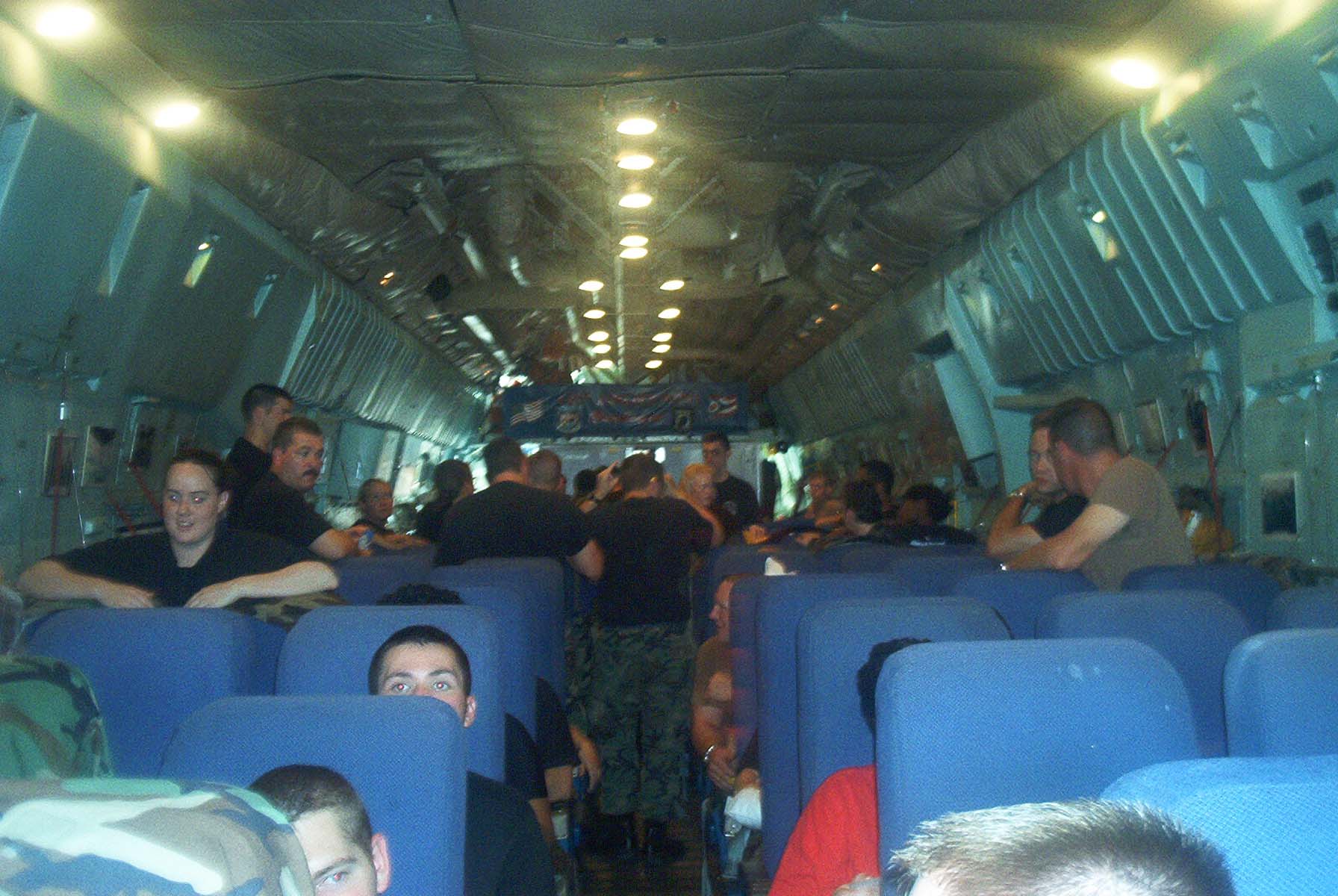
Flightline at Ramstein
===============================================================================
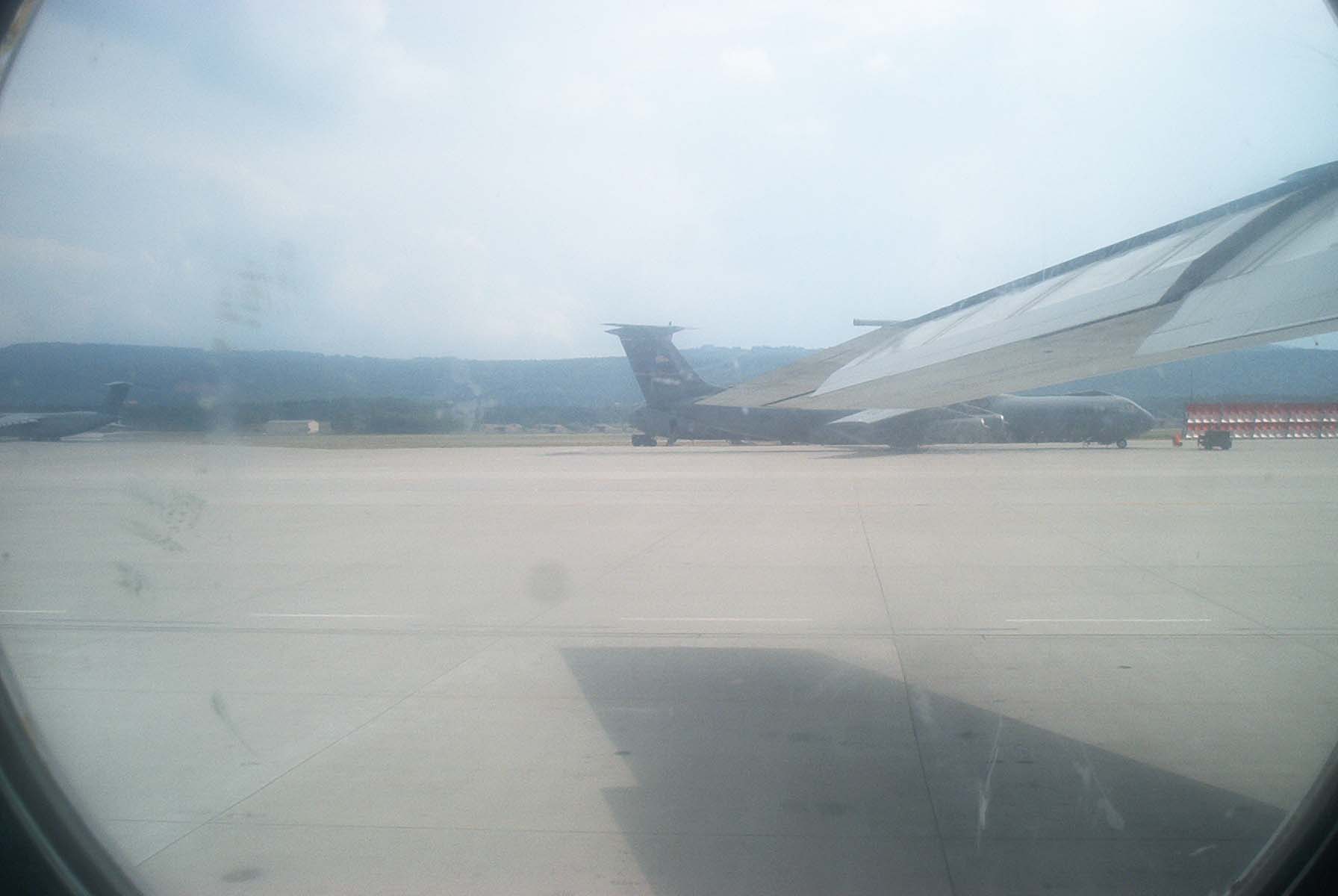
Another C-141 at Ramstein through Window of 177
===============================================================================
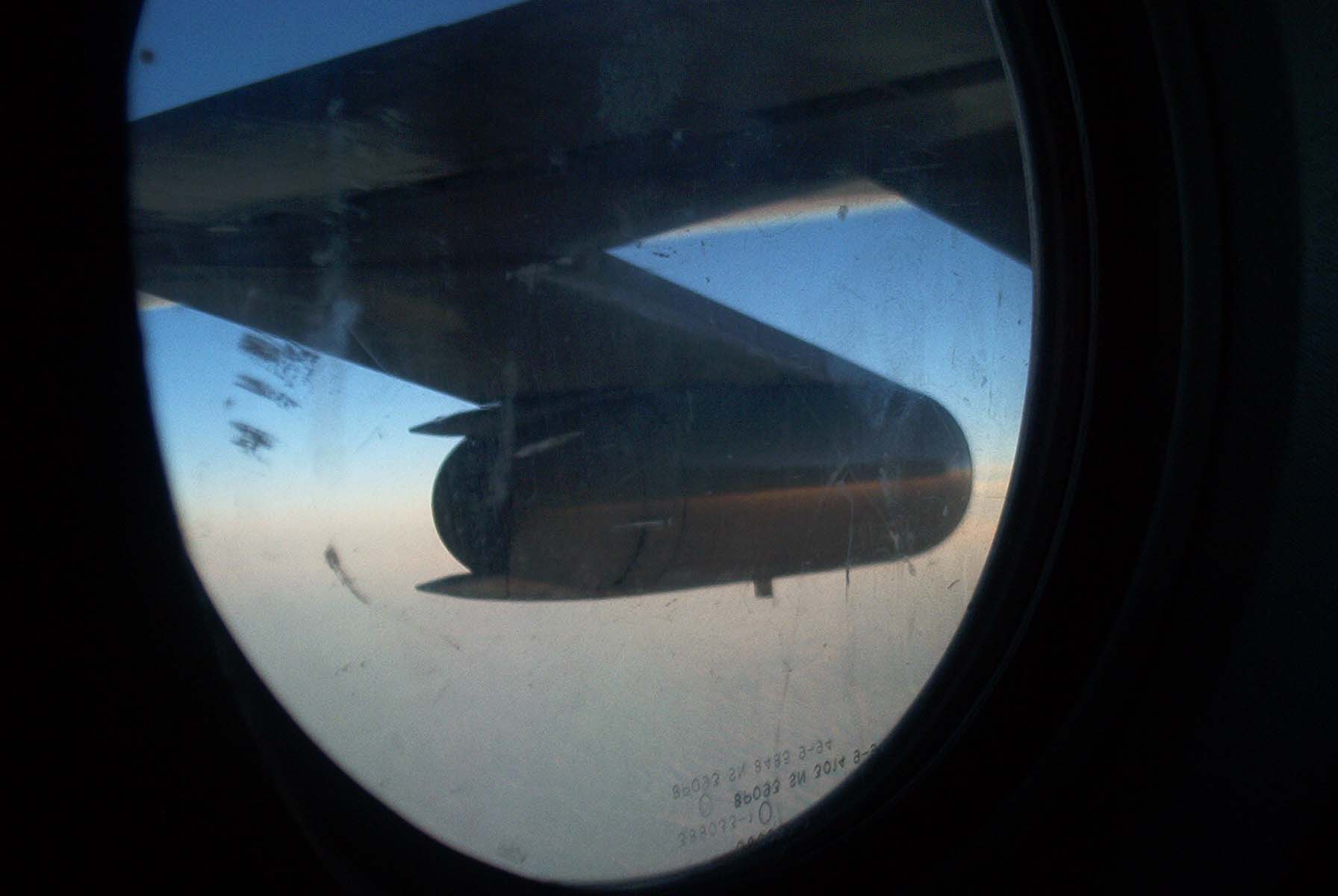
Porthole view from 177
===============================================================================
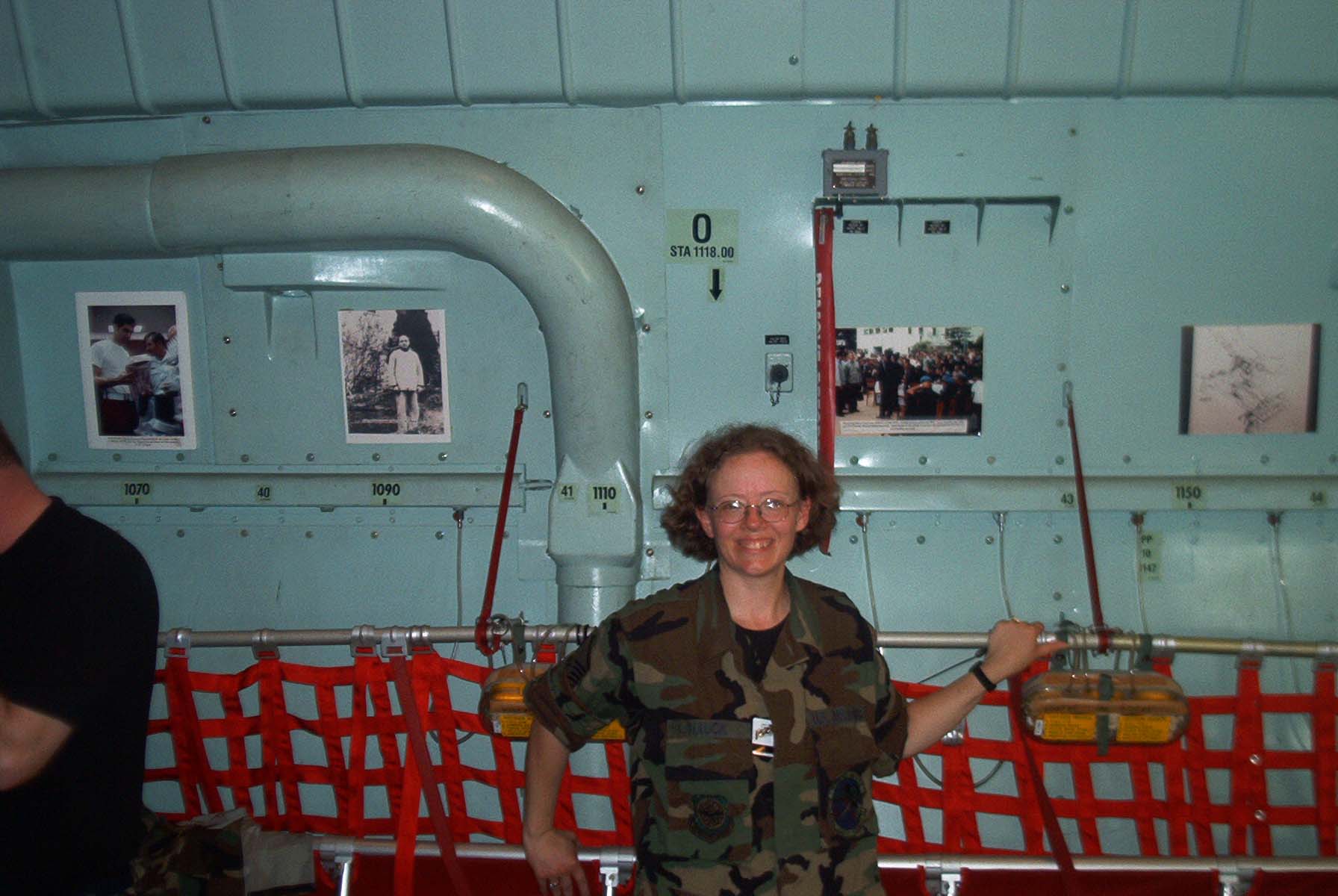
Me inside 177
===============================================================================
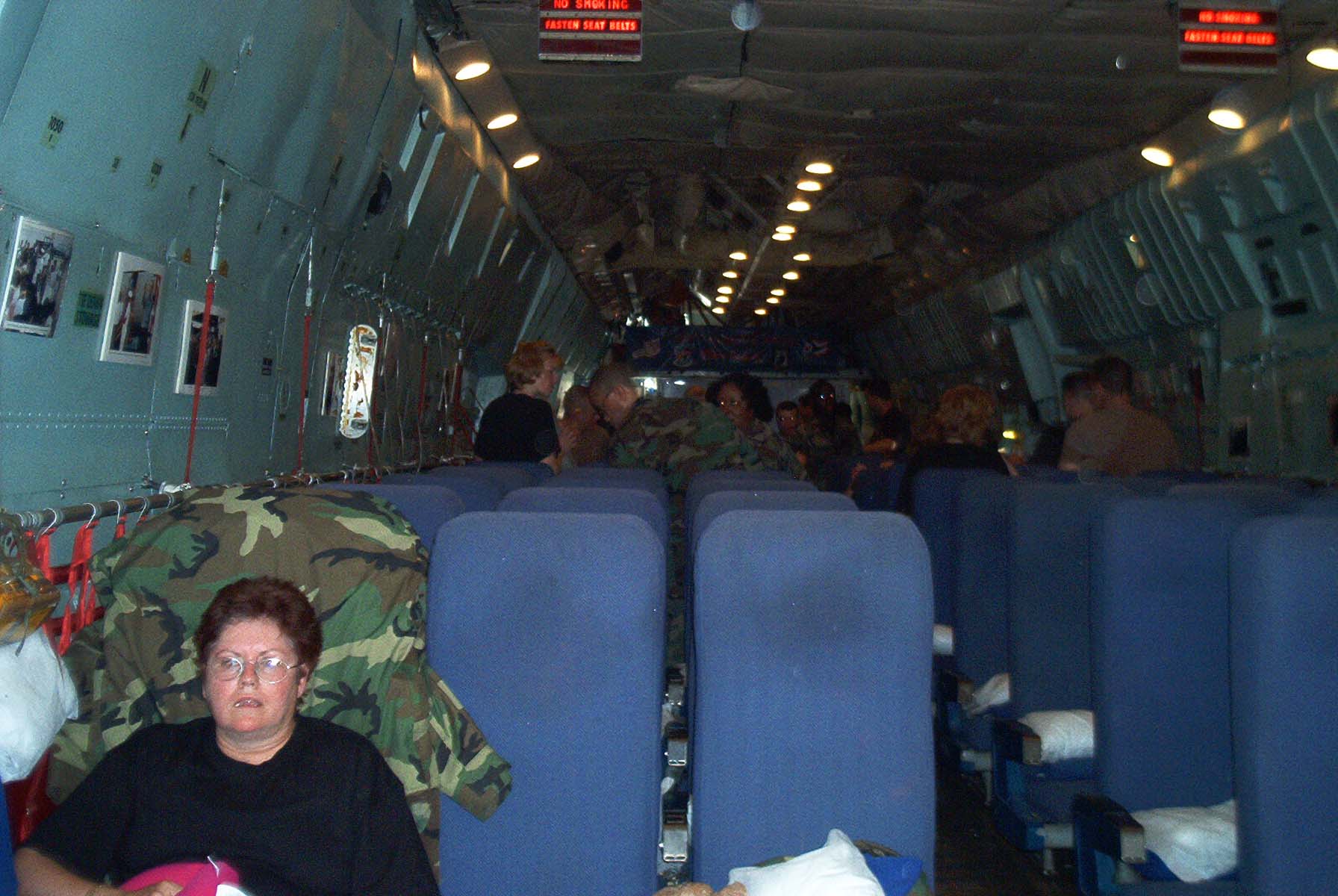
Inside 177 on last overseas flight
===============================================================================
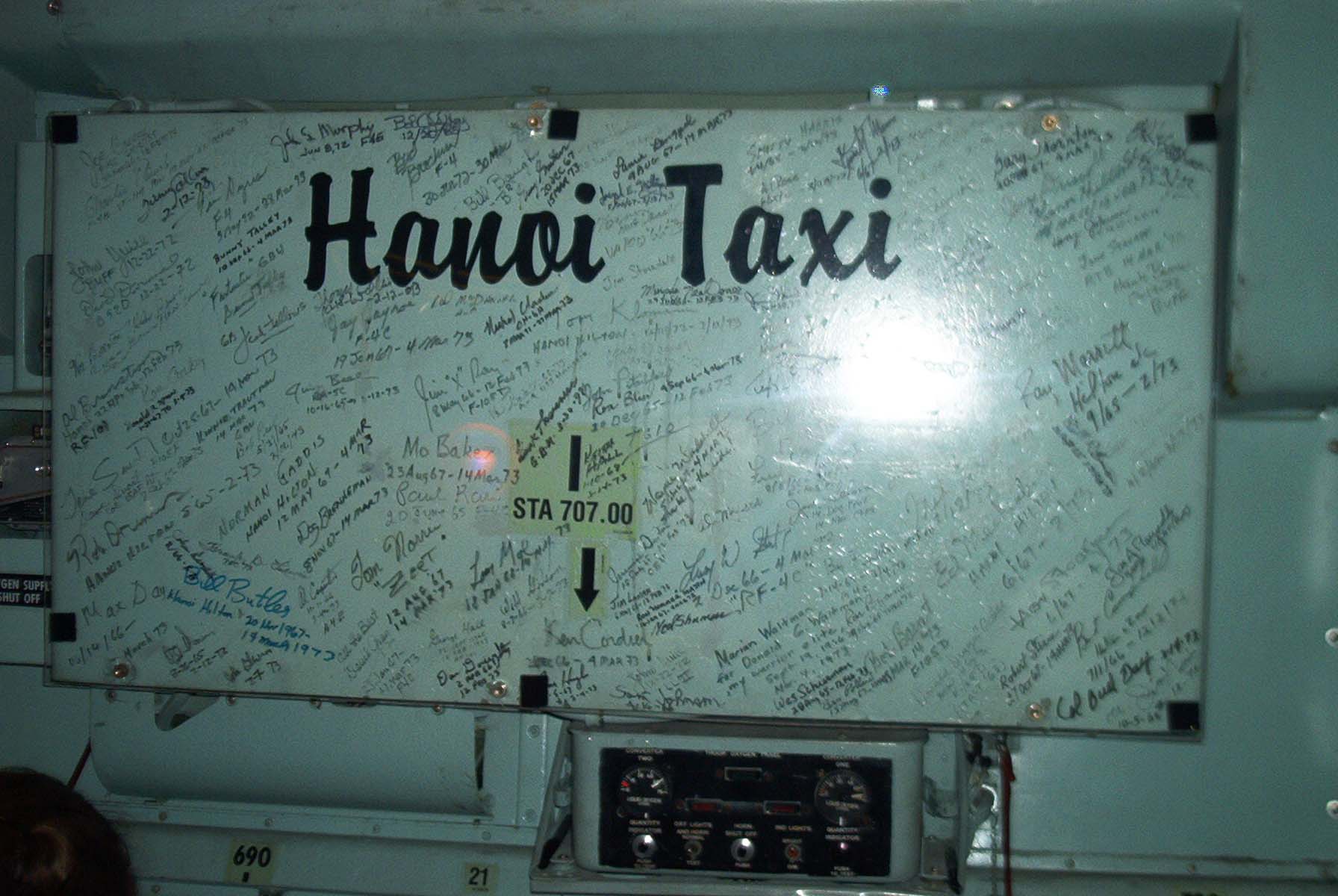
Bulkhead signed by POWS
===============================================================================
When we were at Ramstein we were delayed by several groups of military/former
military who toured the plane and took pictures of her. I plan on visiting the
AF museum often to see her in the future. I'm glad she is not getting scrapped
like the others.
After 15 years supporting C-141s I'm truly going to miss them. We have our
first 2 C-5s. They are 3 times bigger than the 141. It's becoming a different
world here at Wright-Patt.
Hope you are coming to the retirement ceremony on May 5-6.
MSgt. Stefanie Hauck
Logistics Planner
445 LRS/LGRR
These next three photos were taken by Don Russell in February 2001.
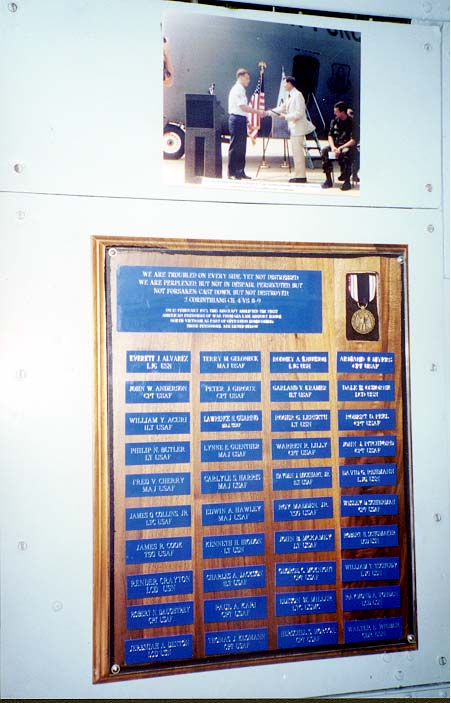
This shows the plaque listing the 40 POW's who were the first to be released on
Feb 12th, 1973.
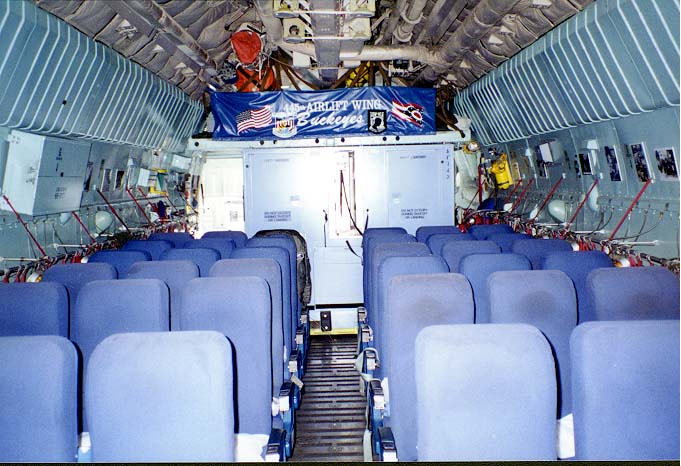
The seats...minus the 40 POW's. That's a "comfort pallet" behind (in front of,
actually) the seats. The comfort pallet contained toilet facilities and better
cooking facilities than the standard C-141 galley, which consisted of a $900
air force coffee maker and a $2,400 oven (metal box with a 15,000 watt heating
element) used to turn frozen TV-style dinners into charcoal.
The seats shown here are the airline style seats, as opposed to the 'fold down'
nylon web troop seats (the red things) that lined both sides of the a/c, all
the airline seats are rear-facing (still the official air force policy).
Both the fold-down seats and the airline seats were as uncomfortable as they look.
Like all things military, the contractor for the airline seats was the low
bidder. The seats contained about 1/2 inch of hard foam. They now sell seats to
the airlines, except smaller and more tightly packed. I always thought the web
seats were more comfortable, especially if the load was light and you could lay
down on them and get some sleep. However, if you were heading home (from
anywhere) or being evacuated from some hot spot or you were a POW just released
and flown to freedom, the airline seats were better than the best Lazyboy
recliner in front of your TV at home. Heaven.
This view is from the back of the a/c looking towards the front.
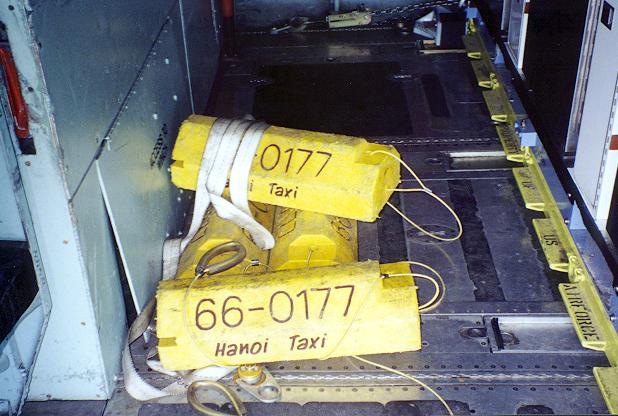
August 10, 2023
Just when I thought there was no new C-141 "news", Chris Behrens, a former
141 flight engineer, sent me a note about the "Flight Engineer's Mailbox" and asked if
I could post a photo of it.
Being clueless, I had no idea what he was
talking about, (I was a pilot, after all), so he sent some photos.
On the FE's panel, in the upper-left corner, there was a filler-plate covering a small, unused
section of the panel. I have no idea what Lockheed might have planned for that little
corner. Maybe a credit-card reader and cash dispenser?
See the photo below for location:
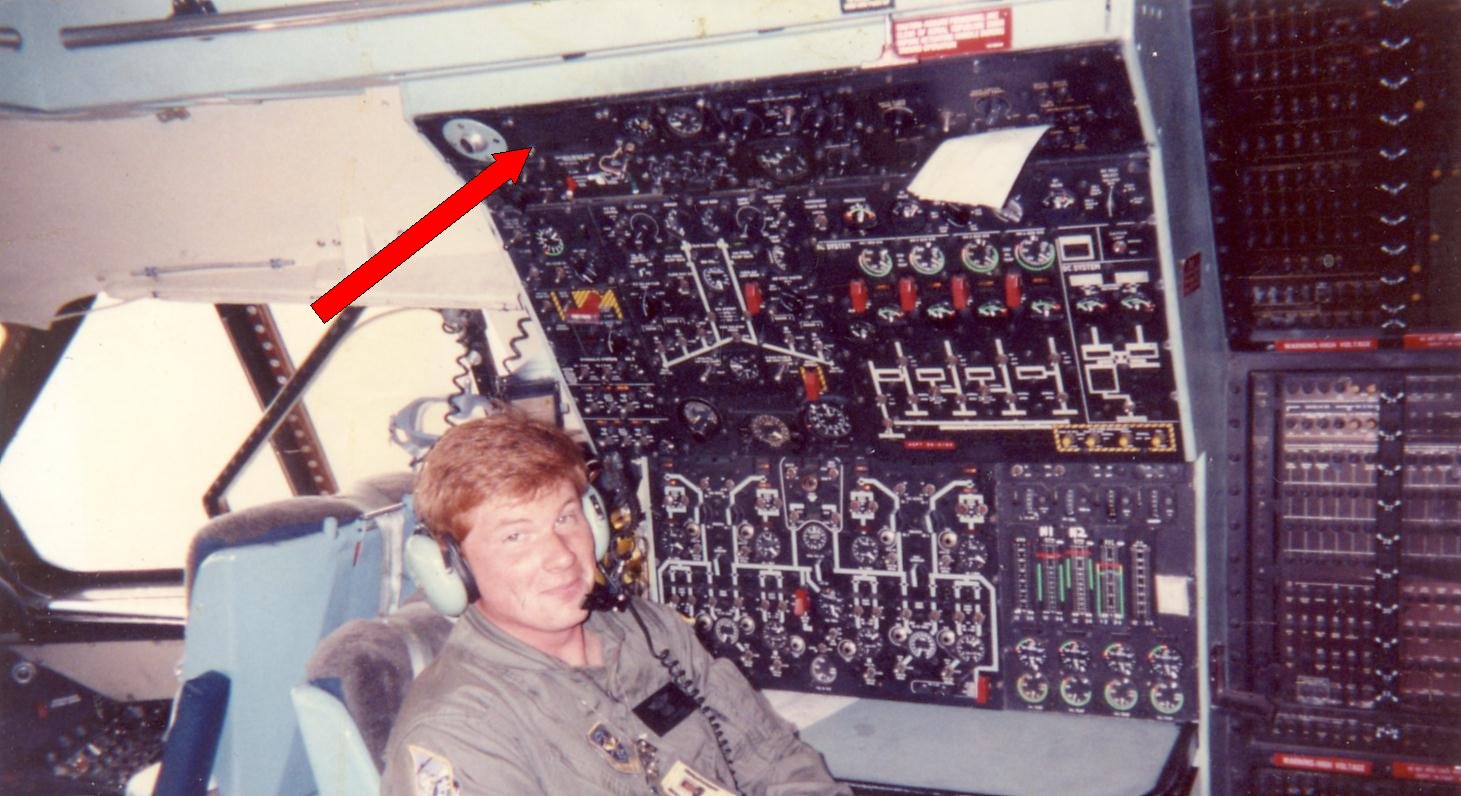
Chris said that FE's would sometimes remove it and scratch a message into the back side
on special occaisions or interesting missions, or just to say hi to each other.
He persuaded the AMC Museum folks at Dover to remove the panel on 64-0626 and take a photo of it.
He's working on getting the AF Museum in Dayton to do the same. If we get a shot of that, I
will add it to this post.
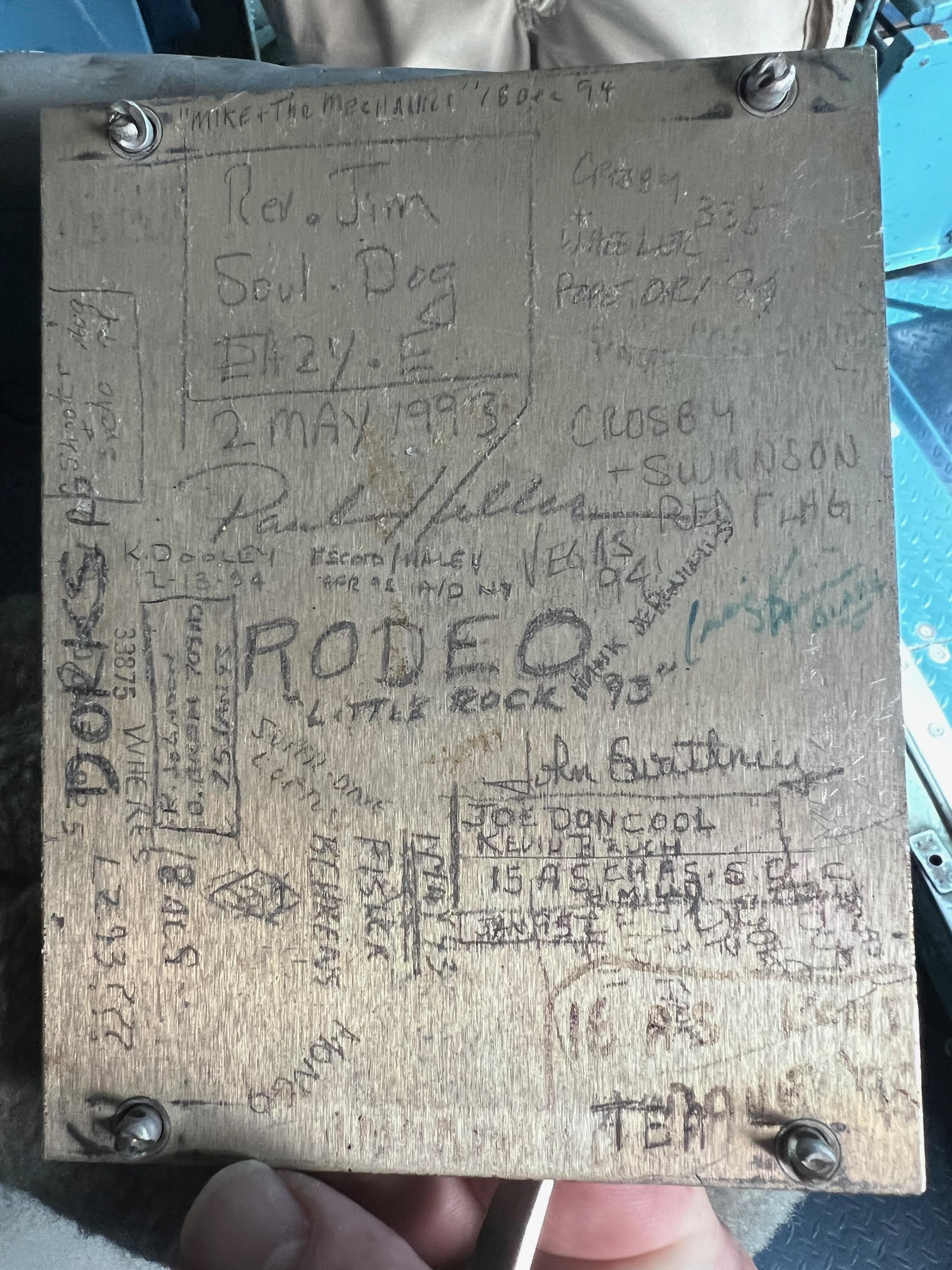
(Hopefully, the statute of limitations for defacing government property has expired by now.)